
- Games & Quizzes
- History & Society
- Science & Tech
- Biographies
- Animals & Nature
- Geography & Travel
- Arts & Culture
- On This Day
- One Good Fact
- New Articles
- Lifestyles & Social Issues
- Philosophy & Religion
- Politics, Law & Government
- World History
- Health & Medicine
- Browse Biographies
- Birds, Reptiles & Other Vertebrates
- Bugs, Mollusks & Other Invertebrates
- Environment
- Fossils & Geologic Time
- Entertainment & Pop Culture
- Sports & Recreation
- Visual Arts
- Demystified
- Image Galleries
- Infographics
- Top Questions
- Britannica Kids
- Saving Earth
- Space Next 50
- Student Center
- Introduction

Introduction and definitions
History and importance.
- Company laboratories
- Government laboratories
- Independent laboratories
- Research associations
- University laboratories
- The role of government
- The management of research and development activities
- Value engineering and cost-benefit analysis
- PERT and CPM

research and development
Our editors will review what you’ve submitted and determine whether to revise the article.
- Corporate Finance Institiute - Research and Development
- Business LibreTexts - An Introduction to Research and Development
- Econlib - Research and Development
- The Canadian Encyclopedia - Industrial Research and Development
- University of California at Berkeley - Econometrics Laboratory - Research and Development
- Table Of Contents

Recent News
research and development , in industry , two intimately related processes by which new products and new forms of old products are brought into being through technological innovation .
Research and development, a phrase unheard of in the early part of the 20th century, has since become a universal watchword in industrialized nations. The concept of research is as old as science; the concept of the intimate relationship between research and subsequent development, however, was not generally recognized until the 1950s. Research and development is the beginning of most systems of industrial production. The innovations that result in new products and new processes usually have their roots in research and have followed a path from laboratory idea, through pilot or prototype production and manufacturing start-up, to full-scale production and market introduction. The foundation of any innovation is an invention . Indeed, an innovation might be defined as the application of an invention to a significant market need. Inventions come from research—careful, focused, sustained inquiry, frequently trial and error. Research can be either basic or applied, a distinction that was established in the first half of the 20th century.
Basic research is defined as the work of scientists and others who pursue their investigations without conscious goals, other than the desire to unravel the secrets of nature. In modern programs of industrial research and development, basic research (sometimes called pure research) is usually not entirely “pure”; it is commonly directed toward a generalized goal, such as the investigation of a frontier of technology that promises to address the problems of a given industry. An example of this is the research being done on gene splicing or cloning in pharmaceutical company laboratories.
Applied research carries the findings of basic research to a point where they can be exploited to meet a specific need, while the development stage of research and development includes the steps necessary to bring a new or modified product or process into production. In Europe , the United States , and Japan the unified concept of research and development has been an integral part of economic planning , both by government and by private industry.
The first organized attempt to harness scientific skill to communal needs took place in the 1790s, when the young revolutionary government in France was defending itself against most of the rest of Europe. The results were remarkable. Explosive shells, the semaphore telegraph, the captive observation balloon, and the first method of making gunpowder with consistent properties all were developed during this period.
The lesson was not learned permanently, however, and another half century was to pass before industry started to call on the services of scientists to any serious extent. At first the scientists consisted of only a few gifted individuals. Robert W. Bunsen, in Germany, advised on the design of blast furnaces. William H. Perkin, in England, showed how dyes could be synthesized in the laboratory and then in the factory. William Thomson (Lord Kelvin), in Scotland, supervised the manufacture of telecommunication cables. In the United States, Leo H. Baekeland, a Belgian, produced Bakelite, the first of the plastics. There were inventors, too, such as John B. Dunlop, Samuel Morse, and Alexander Graham Bell , who owed their success more to intuition , skill, and commercial acumen than to scientific understanding.
While industry in the United States and most of western Europe was still feeding on the ideas of isolated individuals, in Germany a carefully planned effort was being mounted to exploit the opportunities that scientific advances made possible. Siemens, Krupp, Zeiss, and others were establishing laboratories and, as early as 1900, employed several hundred people on scientific research. In 1870 the Physicalische Technische Reichsanstalt (Imperial Institute of Physics and Technology) was set up to establish common standards of measurement throughout German industry. It was followed by the Kaiser Wilhelm Gesellschaft (later renamed the Max Planck Society for the Advancement of Science), which provided facilities for scientific cooperation between companies.
In the United States, the Cambria Iron Company set up a small laboratory in 1867, as did the Pennsylvania Railroad in 1875. The first case of a laboratory that spent a significant part of its parent company’s revenues was that of the Edison Electric Light Company, which employed a staff of 20 in 1878. The U.S. National Bureau of Standards was established in 1901, 31 years after its German counterpart, and it was not until the years immediately preceding World War I that the major American companies started to take research seriously. It was in this period that General Electric , Du Pont, American Telephone & Telegraph, Westinghouse, Eastman Kodak, and Standard Oil set up laboratories for the first time.
Except for Germany, progress in Europe was even slower. When the National Physical Laboratory was founded in England in 1900, there was considerable public comment on the danger to Britain’s economic position of German dominance in industrial research, but there was little action. Even in France, which had an outstanding record in pure science , industrial penetration was negligible.
World War I produced a dramatic change. Attempts at rapid expansion of the arms industry in the belligerent as well as in most of the neutral countries exposed weaknesses in technology as well as in organization and brought an immediate appreciation of the need for more scientific support. The Department of Scientific and Industrial Research in the United Kingdom was founded in 1915, and the National Research Council in the United States in 1916. These bodies were given the task of stimulating and coordinating the scientific support to the war effort, and one of their most important long-term achievements was to convince industrialists, in their own countries and in others, that adequate and properly conducted research and development were essential to success.
At the end of the war the larger companies in all the industrialized countries embarked on ambitious plans to establish laboratories of their own; and, in spite of the inevitable confusion in the control of activities that were novel to most of the participants, there followed a decade of remarkable technical progress. The automobile, the airplane, the radio receiver, the long-distance telephone, and many other inventions developed from temperamental toys into reliable and efficient mechanisms in this period. The widespread improvement in industrial efficiency produced by this first major injection of scientific effort went far to offset the deteriorating financial and economic situation.
The economic pressures on industry created by the Great Depression reached crisis levels by the early 1930s, and the major companies started to seek savings in their research and development expenditure. It was not until World War II that the level of effort in the United States and Britain returned to that of 1930. Over much of the European continent the depression had the same effect, and in many countries the course of the war prevented recovery after 1939. In Germany Nazi ideology tended to be hostile to basic scientific research, and effort was concentrated on short-term work.
The picture at the end of World War II provided sharp contrasts. In large parts of Europe industry had been devastated, but the United States was immensely stronger than ever before. At the same time the brilliant achievements of the men who had produced radar, the atomic bomb , and the V-2 rocket had created a public awareness of the potential value of research that ensured it a major place in postwar plans. The only limit was set by the shortage of trained persons and the demands of academic and other forms of work.
Since 1945 the number of trained engineers and scientists in most industrial countries has increased each year. The U.S. effort has stressed aircraft, defense, space, electronics , and computers. Indirectly, U.S. industry in general has benefited from this work, a situation that compensates in part for the fact that in specifically nonmilitary areas the number of persons employed in the United States is lower in relation to population than in a number of other countries.
Outside the air, space, and defense fields the amount of effort in different industries follows much the same pattern in different countries, a fact made necessary by the demands of international competition. (An exception was the former Soviet Union , which devoted less R and D resources to nonmilitary programs than most other industrialized nations.) An important point is that countries like Japan, which have no significant aircraft or military space industries, have substantially more manpower available for use in the other sectors. The preeminence of Japan in consumer electronics, cameras, and motorcycles and its strong position in the world automobile market attest to the success of its efforts in product innovation and development.
- Search Search Please fill out this field.
What Is Research and Development?
- Understanding R&D
- Types of R&D
- Pros and Cons
- Considerations
- R&D vs. Applied Research
- R&D Tax Credits
The Bottom Line
- Business Essentials
What Is Research and Development (R&D)?
:max_bytes(150000):strip_icc():format(webp)/wk_headshot_aug_2018_02__william_kenton-5bfc261446e0fb005118afc9.jpg)
Investopedia / Ellen Lindner
Research and development (R&D) is the series of activities that companies undertake to innovate. R&D is often the first stage in the development process that results in market research product development, and product testing.
Key Takeaways
- Research and development represents the activities companies undertake to innovate and introduce new products and services or to improve their existing offerings.
- R&D allows a company to stay ahead of its competition by catering to new wants or needs in the market.
- Companies in different sectors and industries conduct R&D—pharmaceuticals, semiconductors, and technology companies generally spend the most.
- R&D is often a broad approach to exploratory advancement, while applied research is more geared towards researching a more narrow scope.
- The accounting for treatment for R&D costs can materially impact a company's income statement and balance sheet.
Understanding Research and Development (R&D)
The concept of research and development is widely linked to innovation both in the corporate and government sectors. R&D allows a company to stay ahead of its competition. Without an R&D program, a company may not survive on its own and may have to rely on other ways to innovate such as engaging in mergers and acquisitions (M&A) or partnerships. Through R&D, companies can design new products and improve their existing offerings.
R&D is distinct from most operational activities performed by a corporation. The research and/or development is typically not performed with the expectation of immediate profit. Instead, it is expected to contribute to the long-term profitability of a company. R&D may often allow companies to secure intellectual property, including patents , copyrights, and trademarks as discoveries are made and products created.
Companies that set up and employ departments dedicated entirely to R&D commit substantial capital to the effort. They must estimate the risk-adjusted return on their R&D expenditures, which inevitably involves risk of capital. That's because there is no immediate payoff, and the return on investment (ROI) is uncertain. As more money is invested in R&D, the level of capital risk increases. Other companies may choose to outsource their R&D for a variety of reasons including size and cost.
Companies across all sectors and industries undergo R&D activities. Corporations experience growth through these improvements and the development of new goods and services. Pharmaceuticals, semiconductors , and software/technology companies tend to spend the most on R&D. In Europe, R&D is known as research and technical or technological development.
Many small and mid-sized businesses may choose to outsource their R&D efforts because they don't have the right staff in-house to meet their needs.
Types of Research and Development (R&D)
There are several different types of R&D that exist in the corporate world and within government. The type used depends entirely on the entity undertaking it and the results can differ.
Basic Research
There are business incubators and accelerators, where corporations invest in startups and provide funding assistance and guidance to entrepreneurs in the hope that innovations will result that they can use to their benefit.
M&As and partnerships are also forms of R&D as companies join forces to take advantage of other companies' institutional knowledge and talent.
Applied Research
One R&D model is a department staffed primarily by engineers who develop new products —a task that typically involves extensive research. There is no specific goal or application in mind with this model. Instead, the research is done for the sake of research.
Development Research
This model involves a department composed of industrial scientists or researchers, all of who are tasked with applied research in technical, scientific, or industrial fields. This model facilitates the development of future products or the improvement of current products and/or operating procedures.
The largest companies may also be the ones that drive the most R&D spend. For example, Amazon has reported $1.147 billion of research and development value on its 2023 annual report.
Advantages and Disadvantages of R&D
There are several key benefits to research and development. It facilitates innovation, allowing companies to improve existing products and services or by letting them develop new ones to bring to the market.
Because R&D also is a key component of innovation, it requires a greater degree of skill from employees who take part. This allows companies to expand their talent pool, which often comes with special skill sets.
The advantages go beyond corporations. Consumers stand to benefit from R&D because it gives them better, high-quality products and services as well as a wider range of options. Corporations can, therefore, rely on consumers to remain loyal to their brands. It also helps drive productivity and economic growth.
Disadvantages
One of the major drawbacks to R&D is the cost. First, there is the financial expense as it requires a significant investment of cash upfront. This can include setting up a separate R&D department, hiring talent, and product and service testing, among others.
Innovation doesn't happen overnight so there is also a time factor to consider. This means that it takes a lot of time to bring products and services to market from conception to production to delivery.
Because it does take time to go from concept to product, companies stand the risk of being at the mercy of changing market trends . So what they thought may be a great seller at one time may reach the market too late and not fly off the shelves once it's ready.
Facilitates innovation
Improved or new products and services
Expands knowledge and talent pool
Increased consumer choice and brand loyalty
Economic driver
Financial investment
Shifting market trends
R&D Accounting
R&D may be beneficial to a company's bottom line, but it is considered an expense . After all, companies spend substantial amounts on research and trying to develop new products and services. As such, these expenses are often reported for accounting purposes on the income statement and do not carry long-term value.
There are certain situations where R&D costs are capitalized and reported on the balance sheet. Some examples include but are not limited to:
- Materials, fixed assets, or other assets have alternative future uses with an estimable value and useful life.
- Software that can be converted or applied elsewhere in the company to have a useful life beyond a specific single R&D project.
- Indirect costs or overhead expenses allocated between projects.
- R&D purchased from a third party that is accompanied by intangible value. That intangible asset may be recorded as a separate balance sheet asset.
R&D Considerations
Before taking on the task of research and development, it's important for companies and governments to consider some of the key factors associated with it. Some of the most notable considerations are:
- Objectives and Outcome: One of the most important factors to consider is the intended goals of the R&D project. Is it to innovate and fill a need for certain products that aren't being sold? Or is it to make improvements on existing ones? Whatever the reason, it's always important to note that there should be some flexibility as things can change over time.
- Timing: R&D requires a lot of time. This involves reviewing the market to see where there may be a lack of certain products and services or finding ways to improve on those that are already on the shelves.
- Cost: R&D costs a great deal of money, especially when it comes to the upfront costs. And there may be higher costs associated with the conception and production of new products rather than updating existing ones.
- Risks: As with any venture, R&D does come with risks. R&D doesn't come with any guarantees, no matter the time and money that goes into it. This means that companies and governments may sacrifice their ROI if the end product isn't successful.
Research and Development vs. Applied Research
Basic research is aimed at a fuller, more complete understanding of the fundamental aspects of a concept or phenomenon. This understanding is generally the first step in R&D. These activities provide a basis of information without directed applications toward products, policies, or operational processes .
Applied research entails the activities used to gain knowledge with a specific goal in mind. The activities may be to determine and develop new products, policies, or operational processes. While basic research is time-consuming, applied research is painstaking and more costly because of its detailed and complex nature.
R&D Tax Credits
The IRS offers a R&D tax credit to encourage innovation and significantly reduction their tax liability. The credit calls for specific types of spend such as product development, process improvement, and software creation.
Enacted under Section 41 of the Internal Revenue Code, this credit encourages innovation by providing a dollar-for-dollar reduction in tax obligations. The eligibility criteria, expanded by the Protecting Americans from Tax Hikes (PATH) Act of 2015, now encompass a broader spectrum of businesses. The credit tens to benefit small-to-midsize enterprises.
To claim R&D tax credits, businesses must document their qualifying expenses and complete IRS Form 6765 (Credit for Increasing Research Activities). The credit, typically ranging from 6% to 8% of annual qualifying expenses, offers businesses a direct offset against federal income tax liabilities. Additionally, businesses can claim up to $250,000 per year against their payroll taxes.
Example of Research and Development (R&D)
One of the more innovative companies of this millennium is Apple Inc. As part of its annual reporting, it has the following to say about its research and development spend:
In 2023, Apple reported having spent $29.915 billion. This is 8% of their annual total net sales. Note that Apple's R&D spend was reported to be higher than the company's selling, general and administrative costs (of $24.932 billion).
Note that the company doesn't go into length about what exactly the R&D spend is for. According to the notes, the company's year-over-year growth was "driven primarily by increases in headcount-related expenses". However, this does not explain the underlying basis carried from prior years (i.e. materials, patents, etc.).
Research and development refers to the systematic process of investigating, experimenting, and innovating to create new products, processes, or technologies. It encompasses activities such as scientific research, technological development, and experimentation conducted to achieve specific objectives to bring new items to market.
What Types of Activities Can Be Found in Research and Development?
Research and development activities focus on the innovation of new products or services in a company. Among the primary purposes of R&D activities is for a company to remain competitive as it produces products that advance and elevate its current product line. Since R&D typically operates on a longer-term horizon, its activities are not anticipated to generate immediate returns. However, in time, R&D projects may lead to patents, trademarks, or breakthrough discoveries with lasting benefits to the company.
Why Is Research and Development Important?
Given the rapid rate of technological advancement, R&D is important for companies to stay competitive. Specifically, R&D allows companies to create products that are difficult for their competitors to replicate. Meanwhile, R&D efforts can lead to improved productivity that helps increase margins, further creating an edge in outpacing competitors. From a broader perspective, R&D can allow a company to stay ahead of the curve, anticipating customer demands or trends.
There are many things companies can do in order to advance in their industries and the overall market. Research and development is just one way they can set themselves apart from their competition. It opens up the potential for innovation and increasing sales. However, it does come with some drawbacks—the most obvious being the financial cost and the time it takes to innovate.
Amazon. " 2023 Annual Report ."
Internal Revenue Service. " Research Credit ."
Internal Revenue Service. " About Form 6765, Credit for Increasing Research Activities ."
Apple. " 2023 Annual Report ."
:max_bytes(150000):strip_icc():format(webp)/research_pharma-5bfc322b46e0fb0051bf11a0.jpg)
- Terms of Service
- Editorial Policy
- Privacy Policy
Building an R&D strategy for modern times
The global investment in research and development (R&D) is staggering. In 2019 alone, organizations around the world spent $2.3 trillion on R&D—the equivalent of roughly 2 percent of global GDP—about half of which came from industry and the remainder from governments and academic institutions. What’s more, that annual investment has been growing at approximately 4 percent per year over the past decade. 1 2.3 trillion on purchasing-power-parity basis; 2019 global R&D funding forecast , Supplement, R&D Magazine, March 2019, rdworldonline.com.
While the pharmaceutical sector garners much attention due to its high R&D spending as a percentage of revenues, a comparison based on industry profits shows that several industries, ranging from high tech to automotive to consumer, are putting more than 20 percent of earnings before interest, taxes, depreciation, and amortization (EBITDA) back into innovation research (Exhibit 1).
What do organizations expect to get in return? At the core, they hope their R&D investments yield the critical technology from which they can develop new products, services, and business models. But for R&D to deliver genuine value, its role must be woven centrally into the organization’s mission. R&D should help to both deliver and shape corporate strategy, so that it develops differentiated offerings for the company’s priority markets and reveals strategic options, highlighting promising ways to reposition the business through new platforms and disruptive breakthroughs.
Yet many enterprises lack an R&D strategy that has the necessary clarity, agility, and conviction to realize the organization’s aspirations. Instead of serving as the company’s innovation engine, R&D ends up isolated from corporate priorities, disconnected from market developments, and out of sync with the speed of business. Amid a growing gap in performance between those that innovate successfully and those that do not, companies wishing to get ahead and stay ahead of competitors need a robust R&D strategy that makes the most of their innovation investments. Building such a strategy takes three steps: understanding the challenges that often work as barriers to R&D success, choosing the right ingredients for your strategy, and then pressure testing it before enacting it.
Overcoming the barriers to successful R&D
The first step to building an R&D strategy is to understand the four main challenges that modern R&D organizations face:
Innovation cycles are accelerating. The growing reliance on software and the availability of simulation and automation technologies have caused the cost of experimentation to plummet while raising R&D throughput. The pace of corporate innovation is further spurred by the increasing emergence of broadly applicable technologies, such as digital and biotech, from outside the walls of leading industry players.
But incumbent corporations are only one part of the equation. The trillion dollars a year that companies spend on R&D is matched by the public sector. Well-funded start-ups, meanwhile, are developing and rapidly scaling innovations that often threaten to upset established business models or steer industry growth into new areas. Add increasing investor scrutiny of research spending, and the result is rising pressure on R&D leaders to quickly show results for their efforts.
R&D lacks connection to the customer. The R&D group tends to be isolated from the rest of the organization. The complexity of its activities and its specialized lexicon make it difficult for others to understand what the R&D function really does. That sense of working inside a “black box” often exists even within the R&D organization. During a meeting of one large company’s R&D leaders, a significant portion of the discussion focused on simply getting everyone up to speed on what the various divisions were doing, let alone connecting those efforts to the company’s broader goals.
Given the challenges R&D faces in collaborating with other functions, going one step further and connecting with customers becomes all the more difficult. While many organizations pay lip service to customer-centric development, their R&D groups rarely get the opportunity to test products directly with end users. This frequently results in market-back product development that relies on a game of telephone via many intermediaries about what the customers want and need.
Projects have few accountability metrics. R&D groups in most sectors lack effective mechanisms to measure and communicate progress; the pharmaceutical industry, with its standard pipeline for new therapeutics that provides well-understood metrics of progress and valuation implications, is the exception, not the rule. When failure is explained away as experimentation and success is described in terms of patents, rather than profits, corporate leaders find it hard to quantify R&D’s contribution.
Yet proven metrics exist to effectively measure progress and outcomes. A common challenge we observe at R&D organizations, ranging from automotive to chemical companies, is how to value the contribution of a single component that is a building block of multiple products. One specialty-chemicals company faced this challenge in determining the value of an ingredient it used in its complex formulations. It created categorizations to help develop initial business cases and enable long-term tracking. This allowed pragmatic investment decisions at the start of projects and helped determine the value created after their completion.
Even with outcomes clearly measured, the often-lengthy period between initial investment and finished product can obscure the R&D organization’s performance. Yet, this too can be effectively managed by tracking the overall value and development progress of the pipeline so that the organization can react and, potentially, promptly reorient both the portfolio and individual projects within it.
Incremental projects get priority. Our research indicates that incremental projects account for more than half of an average company’s R&D investment, even though bold bets and aggressive reallocation of the innovation portfolio deliver higher rates of success. Organizations tend to favor “safe” projects with near-term returns—such as those emerging out of customer requests—that in many cases do little more than maintain existing market share. One consumer-goods company, for example, divided the R&D budget among its business units, whose leaders then used the money to meet their short-term targets rather than the company’s longer-term differentiation and growth objectives.
Focusing innovation solely around the core business may enable a company to coast for a while—until the industry suddenly passes it by. A mindset that views risk as something to be avoided rather than managed can be unwittingly reinforced by how the business case is measured. Transformational projects at one company faced a higher internal-rate-of-return hurdle than incremental R&D, even after the probability of success had been factored into their valuation, reducing their chances of securing funding and tilting the pipeline toward initiatives close to the core.
As organizations mature, innovation-driven growth becomes increasingly important, as their traditional means of organic growth, such as geographic expansion and entry into untapped market segments, diminish. To succeed, they need to develop R&D strategies equipped for the modern era that treat R&D not as a cost center but as the growth engine it can become.
Would you like to learn more about our Strategy & Corporate Finance Practice ?
Choosing the ingredients of a winning r&d strategy.
Given R&D’s role as the innovation driver that advances the corporate agenda, its guiding strategy needs to link board-level priorities with the technologies that are the organization’s focus (Exhibit 2). The R&D strategy must provide clarity and commitment to three central elements: what we want to deliver, what we need to deliver it, and how we will deliver it.
What we want to deliver. To understand what a company wants to and can deliver, the R&D, commercial, and corporate-strategy functions need to collaborate closely, with commercial and corporate-strategy teams anchoring the R&D team on the company’s priorities and the R&D team revealing what is possible. The R&D strategy and the corporate strategy must be in sync while answering questions such as the following: At the highest level, what are the company’s goals? Which of these will require R&D in order to be realized? In short, what is the R&D organization’s purpose?
Bringing the two strategies into alignment is not as easy as it may seem. In some companies, what passes for corporate strategy is merely a five-year business plan. In others, the corporate strategy is detailed but covers only three to five years—too short a time horizon to guide R&D, especially in industries such as pharma or semiconductors where the product-development cycle is much longer than that. To get this first step right, corporate-strategy leaders should actively engage with R&D. That means providing clarity where it is lacking and incorporating R&D feedback that may illuminate opportunities, such as new technologies that unlock growth adjacencies for the company or enable completely new business models.
Secondly, the R&D and commercial functions need to align on core battlegrounds and solutions. Chief technology officers want to be close to and shape the market by delivering innovative solutions that define new levels of customer expectations. Aligning R&D strategy provides a powerful forum for identifying those opportunities by forcing conversations about customer needs and possible solutions that, in many companies, occur only rarely. Just as with the corporate strategy alignment, the commercial and R&D teams need to clearly articulate their aspirations by asking questions such as the following: Which markets will make or break us as a company? What does a winning product or service look like for customers?
When defining these essential battlegrounds, companies should not feel bound by conventional market definitions based on product groups, geographies, or customer segments. One agricultural player instead defined its markets by the challenges customers faced that its solutions could address. For example, drought resistance was a key battleground no matter where in the world it occurred. That framing clarified the R&D–commercial strategy link: if an R&D project could improve drought resistance, it was aligned to the strategy.
The dialogue between the R&D, commercial, and strategy functions cannot stop once the R&D strategy is set. Over time, leaders of all three groups should reexamine the strategic direction and continuously refine target product profiles as customer needs and the competitive landscape evolve.
What we need to deliver it. This part of the R&D strategy determines what capabilities and technologies the R&D organization must have in place to bring the desired solutions to market. The distinction between the two is subtle but important. Simply put, R&D capabilities are the technical abilities to discover, develop, or scale marketable solutions. Capabilities are unlocked by a combination of technologies and assets, and focus on the outcomes. Technologies, however, focus on the inputs—for example, CRISPR is a technology that enables the genome-editing capability.
This delineation protects against the common pitfall of the R&D organization fixating on components of a capability instead of the capability itself—potentially missing the fact that the capability itself has evolved. Consider the dawn of the digital age: in many engineering fields, a historical reliance on talent (human number crunchers) was suddenly replaced by the need for assets (computers). Those who focused on hiring the fastest mathematicians were soon overtaken by rivals who recognized the capability provided by emerging technologies.
The simplest way to identify the needed capabilities is to go through the development processes of priority solutions step by step—what will it take to produce a new product or feature? Being exhaustive is not the point; the goal is to identify high-priority capabilities, not to log standard operating procedures.
Prioritizing capabilities is a critical but often contentious aspect of developing an R&D strategy. For some capabilities, being good is sufficient. For others, being best in class is vital because it enables a faster path to market or the development of a better product than those of competitors. Take computer-aided design (CAD), which is used to design and prototype engineering components in numerous industries, such as aerospace or automotive. While companies in those sectors need that capability, it is unlikely that being the best at it will deliver a meaningful advantage. Furthermore, organizations should strive to anticipate which capabilities will be most important in the future, not what has mattered most to the business historically.
Once capabilities are prioritized, the R&D organization needs to define what being “good” and “the best” at them will mean over the course of the strategy. The bar rises rapidly in many fields. Between 2009 and 2019, the cost of sequencing a genome dropped 150-fold, for example. 2 Kris A. Wetterstrand, “DNA sequencing costs: Data,” NHGRI Genome Sequencing Program (GSP), August 25, 2020, genome.gov. Next, the organization needs to determine how to develop, acquire, or access the needed capabilities. The decision of whether to look internally or externally is crucial. An automatic “we can build it better” mindset diminishes the benefits of specialization and dilutes focus. Additionally, the bias to building everything in-house can cut off or delay access to the best the world has to offer—something that may be essential for high-priority capabilities. At Procter & Gamble, it famously took the clearly articulated aspiration of former CEO A. G. Lafley to break the company’s focus on in-house R&D and set targets for sourcing innovation externally. As R&D organizations increasingly source capabilities externally, finding partners and collaborating with them effectively is becoming a critical capability in its own right.
How we will do it. The choices of operating model and organizational design will ultimately determine how well the R&D strategy is executed. During the strategy’s development, however, the focus should be on enablers that represent cross-cutting skills and ways of working. A strategy for attracting, developing, and retaining talent is one common example.
Another is digital enablement, which today touches nearly every aspect of what the R&D function does. Artificial intelligence can be used at the discovery phase to identify emerging market needs or new uses of existing technology. Automation and advanced analytics approaches to experimentation can enable high throughput screening at a small scale and distinguish the signal from the noise. Digital (“in silico”) simulations are particularly valuable when physical experiments are expensive or dangerous. Collaboration tools are addressing the connectivity challenges common among geographically dispersed project teams. They have become indispensable in bringing together existing collaborators, but the next horizon is to generate the serendipity of chance encounters that are the hallmark of so many innovations.
Testing your R&D strategy
Developing a strategy for the R&D organization entails some unique challenges that other functions do not face. For one, scientists and engineers have to weigh considerations beyond their core expertise, such as customer, market, and economic factors. Stakeholders outside R&D labs, meanwhile, need to understand complex technologies and development processes and think along much longer time horizons than those to which they are accustomed.
For an R&D strategy to be robust and comprehensive enough to serve as a blueprint to guide the organization, it needs to involve stakeholders both inside and outside the R&D group, from leading scientists to chief commercial officers. What’s more, its definition of capabilities, technologies, talent, and assets should become progressively more granular as the strategy is brought to life at deeper levels of the R&D organization. So how can an organization tell if its new strategy passes muster? In our experience, McKinsey’s ten timeless tests of strategy apply just as well to R&D strategy as to corporate and business-unit strategies. The following two tests are the most important in the R&D context:
- Does the organization’s strategy tap the true source of advantage? Too often, R&D organizations conflate technical necessity (what is needed to develop a solution) with strategic importance (distinctive capabilities that allow an organization to develop a meaningfully better solution than those of their competitors). It is also vital for organizations to regularly review their answers to this question, as capabilities that once provided differentiation can become commoditized and no longer serve as sources of advantage.
- Does the organization’s strategy balance commitment-rich choices with flexibility and learning? R&D strategies may have relatively long time horizons but that does not mean they should be insulated from changes in the outside world and never revisited. Companies should establish technical, regulatory, or other milestones that serve as clear decision points for shifting resources to or away from certain research areas. Such milestones can also help mark progress and gauge whether strategy execution is on track.
Additionally, the R&D strategy should be simply and clearly communicated to other functions within the company and to external stakeholders. To boost its clarity, organizations might try this exercise: distill the strategy into a set of fill-in-the-blank components that define, first, how the world will evolve and how the company plans to refocus accordingly (for example, industry trends that may lead the organization to pursue new target markets or segments); next, the choices the R&D function will make in order to support the company’s new focus (which capabilities will be prioritized and which de-emphasized); and finally, how the R&D team will execute the strategy in terms of concrete actions and milestones. If a company cannot fit the exercise on a single page, it has not sufficiently synthesized the strategy—as the famed physicist Richard Feynman observed, the ultimate test of comprehension is the ability to convey something to others in a simple manner.
Cascading the strategy down through the R&D organization will further reinforce its impact. For example, asking managers to communicate the strategy to their subordinates will deepen their own understanding. A useful corollary is that those hearing the strategy for the first time are introduced to it by their immediate supervisors rather than more distant R&D leaders. One R&D group demonstrated the broad benefits of this communication model: involving employees in developing and communicating the R&D strategy helped it double its Organizational Health Index strategic clarity score, which measures one of the four “power practices” highly connected to organizational performance.
R&D represents a massive innovation investment, but as companies confront globalized competition, rapidly changing customer needs, and technological shifts coming from an ever-wider range of fields, they are struggling to deliver on R&D’s full potential. A clearly articulated R&D strategy that supports and informs the corporate strategy is necessary to maximize the innovation investment and long-term company value.
Explore a career with us
Related articles.
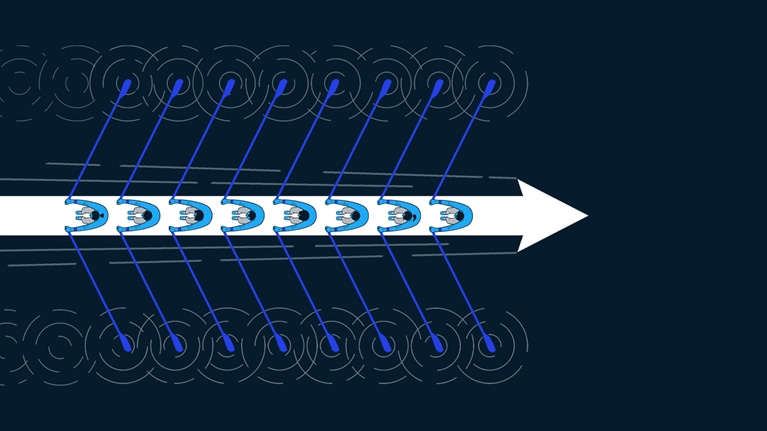
The innovation commitment

The eight essentials of innovation

The Committed Innovator: An interview with Salesforce’s Simon Mulcahy
- Start free trial
Start selling with Shopify today
Start your free trial with Shopify today—then use these resources to guide you through every step of the process.

What Is Research and Development (R&D)? Definition and Guide
Learn the definition of research and development, the types of R&D, and the benefits and risks of investing in research and development for your business

When it comes to the products and ideas that revolutionize and reshape our world, it can be tempting to imagine them springing from a singular moment of inspiration (think Isaac Newton and the apple).
The truth, however, is that in any industry, the most innovative and successful products are typically the result of years of study, experimentation, and hard work. That process is known as research and development—and whether you're running a high-tech Fortune 500 company or a small online store, it can be the first step to incredible success.
In this guide, you'll learn the definition of research and development, as well as the potential benefits and risks of investing in the practice.
What is research and development?
Research and Development is a systematic activity that companies undertake to innovate and introduce new products and services or to improve their existing offerings.
Many people think of pharmaceutical and technology companies when they hear “R&D,” but other firms, including those that produce consumer products, invest time and resources into R&D as well. For example, a spaghetti sauce brand's many variations on the original product – “Chunky Garden,” “Four Cheese,” and “Tomato Basil Garlic”– are the results of extensive R&D.
Any business that creates and sells a product or service, whether it's software or spark plugs, invests in some level of R&D .
Basic vs. applied research
Research and development comes in two main types: basic, and applied.
Basic research
Basic research (also known as fundamental research) is focused on improving our understanding of a particular problem or phenomenon through exploration of big questions. Some examples of basic research questions are:
- Why do mice get caught in traps?
- Why are some people allergic to gluten?
While basic research can certainly help a company acquire new knowledge, its focus on research for its own sake means that the financial benefits are uncertain. Consequently, this type of research and development is primarily performed by large corporations, universities, and government agencies.
Applied research
Applied research is also done to acquire knowledge. But unlike basic research, it's done with a specific goal, use, or product in mind. Where basic research is theoretical, applied research is practical, with a focus on finding workable solutions for current problems. Some examples of applied research questions include:
- How can we build a better mousetrap?
- What combination of flours will produce the best gluten-free pie crust?
Why invest in research and development?
While the overarching goal of research and development is to add to a company's bottom line, companies undertake R&D for a variety of reasons.
- Create new and improved products: Whether you're starting a new company, or looking to expand your existing offerings, innovation research can help you meet customer demands for new and better products that solve their problems more quickly and easily.
- Increase business efficiency: R&D can help you gain knowledge about your production processes, business structure, and place in the market, providing insights that increase productivity by eliminating time-consuming inefficiencies and allocating resources to the most impactful projects.
- Reduce costs: Profits aren't the only way that research and development can pay off. In fact, many companies focus their R&D on improving existing technologies and processes for internal use, reducing the overall cost of bringing your products to market.
- Remain competitive: Research and development is a great way to stay ahead of the competition . By investing in emerging technologies that improve your products, you can gain a competitive edge over even the most established firms.
- Secure investment: Even if your research efforts aren't immediately profitable, they may point to future innovations or developments that investors are excited to support.
Who handles research and development?
Often, research and development is handled in house by an internal department in a company, but it can also be outsourced to a specialist or a university. Large multinational companies might do all three, and some of the outsourced work might be done in another country so that the company leverages both the talent and local market knowledge there.
Outsourced R&D is especially appealing to the small business owner who has a new product concept but lacks the design or engineering staff needed to create and test options. Solopreneurs who offer software as a service are an example on the smallest scale, as they sometimes outsource the R&D and resulting software development.
R&D and accounting
There are no guarantees when it comes to research and development, and it's very unlikely to lead to an immediate profit. Often, a company will spend a large amount of money in search of a better method, material, or medication, and never see a return on the investment. In this sense R&D is not an asset: it's a business expense . For that reason, general accounting standards and practices dictate that most (but not all) costs associated with research and development be charged to expense as incurred.
That said, businesses can mitigate some of the impacts of research and development by leveraging federal tax breaks and deductions focused on promoting R&D.
- The 11 Most Important Sales Channels for Ecommerce Stores [+ Examples
- 5 Winning Facebook Ad Strategies to Try
- 7 Ways Small Businesses Can Save Money in Their First Year
- How Recurring Payments Work for Small Business Owners
- What Does Small Business Insurance Cost?
- Ecommerce Accounting for Small Business Owners
- What Are Current Assets? How To Calculate Current Assets
- Funding Female Founders- Small-Business Loans for Women and Where to Apply for Them
- Shipping Trends: How To Deliver on Your Customers’ Shipping Expectations
Research and development FAQ
What does r&d stand for, why is research and development important, what are the challenges of research and development, what is the difference between r&d and product development.
Keep up with the latest from Shopify
Get free ecommerce tips, inspiration, and resources delivered directly to your inbox.
By entering your email, you agree to receive marketing emails from Shopify.
popular posts

The point of sale for every sale.

Subscribe to our blog and get free ecommerce tips, inspiration, and resources delivered directly to your inbox.
Unsubscribe anytime. By entering your email, you agree to receive marketing emails from Shopify.
Latest from Shopify
Jun 15, 2024
Jun 14, 2024
Learn on the go. Try Shopify for free, and explore all the tools you need to start, run, and grow your business.
Try Shopify for free, no credit card required.
Research and Development (R&D)
- Reference work entry
- pp 5516–5517
- Cite this reference work entry

- Sakari Kainulainen 3
695 Accesses
Mode 2 knowledge production (Mode 2) ; Mode 2 knowledge production ; Research and development and innovations (R&D&I)
Research and development (R&D) is a broad category describing the entity of basic research, applied research, and development activities. In general research and development means systematic activities in order to increase knowledge and use of this knowledge when developing new products, processes, or services. Nowadays innovation activities are strongly tight into the concept of research and development. In the broadest meaning, research and development consists of every activity from the basic research to the (successful) marketing of a product or (effective) launching of a new process (R&D&I).
Description
Research and development work is mostly related to business organizations. Development activities are targeted for them to development of new products and their success within the markets. A new product can be seen as the end of the chain of which...
This is a preview of subscription content, log in via an institution to check access.
Access this chapter
- Available as PDF
- Read on any device
- Instant download
- Own it forever
- Available as EPUB and PDF
- Durable hardcover edition
- Dispatched in 3 to 5 business days
- Free shipping worldwide - see info
Tax calculation will be finalised at checkout
Purchases are for personal use only
Institutional subscriptions
Gibbons, M., Limoges, C., Nowotny, H., Schwartzman, S., Scott, P., & Trow, M. (1994). The new production of knowledge: The dynamics of science and research in contemporary societies . London: Sage.
Google Scholar
Gulbrandsen, M. The role of basic research in innovation. Confluence , 55 . Retrieved from http://www.cas.uio.no/Publications/Seminar/Confluence_Gulbrandsen.pdf
Download references
Author information
Authors and affiliations.
Diaconia University of Applied Sciences, Sturenkatu 2, Helsinki, 00510, Finland
Sakari Kainulainen
You can also search for this author in PubMed Google Scholar
Corresponding author
Correspondence to Sakari Kainulainen .
Editor information
Editors and affiliations.
University of Northern British Columbia, Prince George, BC, Canada
Alex C. Michalos
(residence), Brandon, MB, Canada
Rights and permissions
Reprints and permissions
Copyright information
© 2014 Springer Science+Business Media Dordrecht
About this entry
Cite this entry.
Kainulainen, S. (2014). Research and Development (R&D). In: Michalos, A.C. (eds) Encyclopedia of Quality of Life and Well-Being Research. Springer, Dordrecht. https://doi.org/10.1007/978-94-007-0753-5_2482
Download citation
DOI : https://doi.org/10.1007/978-94-007-0753-5_2482
Publisher Name : Springer, Dordrecht
Print ISBN : 978-94-007-0752-8
Online ISBN : 978-94-007-0753-5
eBook Packages : Humanities, Social Sciences and Law
Share this entry
Anyone you share the following link with will be able to read this content:
Sorry, a shareable link is not currently available for this article.
Provided by the Springer Nature SharedIt content-sharing initiative
- Publish with us
Policies and ethics
- Find a journal
- Track your research
Research and Development
Research and development are the processes businesses follow to develop and introduce new products and improve existing services.
Home > Research Glossary > Research and Development
What is research and development?
Research and development (R&D) refers to the activities that businesses engage in to:
- Develop and introduce new products and services or
- Innovate and improve on existing products and services
R&D can be an invaluable tool for building and enhancing your business. It involves conducting a thorough investigation into your industry, your competitors, and your customers and uncovering the data and insights that are most important to your company.
Armed with this information, you can be more strategic and better informed for meeting the needs of both your customers and your organization. So, finding this type of accurate, complete information in a timely fashion is essential to making smarter, more impactful business decisions.
Why are data and insights important for your R&D strategy
Data and the insights you draw from that data are critical to any R&D strategy. They help you:
- Paint a more complete picture of the industry landscape, of a competitor, or of a particular individual
- Identify existing or emerging trends
- Unlock new business opportunities
- Build successful strategies so you can confidently make the right decisions for your organization
- Mitigate market disruptions and be risk resilient
What’s more, data provides crucial insights into the factors influencing your business not just today, but also well into the future. Equipped with this knowledge, you’re in a much stronger position to create long-term value for your customers, markets, and relationships.
What kind of data do you need for your R&D strategy
No one can dispute that the Internet is an amazing tool. With it, we have at our fingertips immediate access to seemingly immeasurable amounts of free data – facts, statistics, and insights. But the Internet also comes with its limitations and hazards, especially when it comes to important research. Some challenges of using only the open web to conduct research include:
- Questionable sources
- Outdated information
- Fake news or misinformation
- Inconvenient paywalls or other research dead ends
- Information gaps or, conversely, content overload
In today's information-on-demand age, traditional search engines and general online research just won’t suffice for a robust R&D strategy. You need a smarter, more efficient approach, one that:
- Avoids these internet obstacles
- Takes your research beyond the one-dimensional and draws from wide-ranging, first-rate sources
- Indexes and filters the research, so you’re getting only the data that’s most important to your organization
- Turns that data into actionable insights that strengthen your decision-making and help you achieve your business objectives
So, it’s not about just any data – it’s about the right data. Trusted, well-vetted, and comprehensive information is critical for robust R&D. That means knowing where to get such valuable data and having the research tools in place to deliver it are key to developing a successful R&D strategy.
How LexisNexis supports research and development
Nexis ® supplies content from the world's leading publishers. It aggregates information from more than 40,000 international news and business outlets, as well as from thousands of business-relevant websites, blogs, and forums. Tens of thousands of sources and millions of documents are at your disposal for company research.
It enables you to search this expertly curated content for all the relevant, credible, quality information you need – all in one place – and access reports, data, and info that’s often locked behind a paywall. You can organize and keep track of your research using alerts, personalized dashboards, reports, and customizable analyses.
START A FREE TRIAL
You may also be interested in
Market research.
Valid business information and market data as the basis of market intelligence.
Opposition Research
Conduct opposition research to gain a better idea of the landscape in which you’re competing.
Have Questions?
Connect with an expert to discuss your Research needs. Complete the form below or call us at 1-888-46-NEXIS .

- school Campus Bookshelves
- menu_book Bookshelves
- perm_media Learning Objects
- login Login
- how_to_reg Request Instructor Account
- hub Instructor Commons
Margin Size
- Download Page (PDF)
- Download Full Book (PDF)
- Periodic Table
- Physics Constants
- Scientific Calculator
- Reference & Cite
- Tools expand_more
- Readability
selected template will load here
This action is not available.

13.1: An Introduction to Research and Development (R&D)
- Last updated
- Save as PDF
- Page ID 16730

\( \newcommand{\vecs}[1]{\overset { \scriptstyle \rightharpoonup} {\mathbf{#1}} } \)
\( \newcommand{\vecd}[1]{\overset{-\!-\!\rightharpoonup}{\vphantom{a}\smash {#1}}} \)
\( \newcommand{\id}{\mathrm{id}}\) \( \newcommand{\Span}{\mathrm{span}}\)
( \newcommand{\kernel}{\mathrm{null}\,}\) \( \newcommand{\range}{\mathrm{range}\,}\)
\( \newcommand{\RealPart}{\mathrm{Re}}\) \( \newcommand{\ImaginaryPart}{\mathrm{Im}}\)
\( \newcommand{\Argument}{\mathrm{Arg}}\) \( \newcommand{\norm}[1]{\| #1 \|}\)
\( \newcommand{\inner}[2]{\langle #1, #2 \rangle}\)
\( \newcommand{\Span}{\mathrm{span}}\)
\( \newcommand{\id}{\mathrm{id}}\)
\( \newcommand{\kernel}{\mathrm{null}\,}\)
\( \newcommand{\range}{\mathrm{range}\,}\)
\( \newcommand{\RealPart}{\mathrm{Re}}\)
\( \newcommand{\ImaginaryPart}{\mathrm{Im}}\)
\( \newcommand{\Argument}{\mathrm{Arg}}\)
\( \newcommand{\norm}[1]{\| #1 \|}\)
\( \newcommand{\Span}{\mathrm{span}}\) \( \newcommand{\AA}{\unicode[.8,0]{x212B}}\)
\( \newcommand{\vectorA}[1]{\vec{#1}} % arrow\)
\( \newcommand{\vectorAt}[1]{\vec{\text{#1}}} % arrow\)
\( \newcommand{\vectorB}[1]{\overset { \scriptstyle \rightharpoonup} {\mathbf{#1}} } \)
\( \newcommand{\vectorC}[1]{\textbf{#1}} \)
\( \newcommand{\vectorD}[1]{\overrightarrow{#1}} \)
\( \newcommand{\vectorDt}[1]{\overrightarrow{\text{#1}}} \)
\( \newcommand{\vectE}[1]{\overset{-\!-\!\rightharpoonup}{\vphantom{a}\smash{\mathbf {#1}}}} \)
Learning Objectives
- Know what constitutes research and development (R&D).
- Understand the importance of R&D to corporations.
- Recognize the role government plays in R&D.
Research and development (R&D) refers to two intertwined processes of research (to identify new knowledge and ideas) and development (turning the ideas into tangible products or processes). Companies undertake R&D in order to develop new products, services, or procedures that will help them grow and expand their operations. Corporate R&D began in the United States with Thomas Edison and the Edison General Electric Company he founded in 1890 (which is today’s GE). Edison is credited with 1,093 patents, but it’s actually his invention of the corporate R&D lab that made all those other inventions possible.Andrea Meyer, “High-Value Innovation: Innovating the Management of Innovation,” Working Knowledge (blog), August 20, 2009, accessed February 22, 2011, http://workingknowledge.com/blog/?p=594 . Edison was the first to bring management discipline to R&D, which enabled a much more powerful method of invention by systematically harnessing the talent of many individuals. Edison’s 1,093 patents had less to do with individual genius and more to do with management genius: creating and managing an R&D lab that could efficiently and effectively crank out new inventions. For fifty years following the early twentieth century, GE was awarded more patents than any other firm in America.Gary Hamel, “The Why, What and How of Management Innovation,” Harvard Business Review , February 2006, accessed February 24, 2011, http://hbr.org/2006/02/the-why-what-and-how-of-management-innovation/ar/1 .
Edison is known as an inventor, but he was also a great innovator. Here’s the difference: an invention brings an idea into tangible reality by embodying it as a product or system. An innovation converts a new idea into revenues and profits. Inventors can get patents on original ideas, but those inventions may not make money. For an invention to become an innovation, people must be willing to buy it in high enough numbers that the firm benefits from making it.A. G. Lafley and Ram Charan, The Game-Changer (New York: Crown Publishing Group, 2008), 21.
Edison wanted his lab to be a commercial success. “Anything that won’t sell, I don’t want to invent. Its sale is proof of utility and utility is success,”A. G. Lafley and Ram Charan, The Game-Changer (New York: Crown Publishing Group, 2008), 25. Edison said. Edison’s lab in Menlo Park, New Jersey, was an applied research lab, which is a lab that develops and commercializes its research findings. As defined by the National Science Foundation, applied research is “systematic study to gain knowledge or understanding necessary to determine the means by which a recognized and specific need may be met.”National Science Foundation, “Definitions of Research and Development,” Office of Management and Budget Circular A-11, accessed March 5, 2011, http://www.nsf.gov/statistics/randdef/fedgov.cfm . In contrast, basic research advances the knowledge of science without an explicit, anticipated commercial outcome.
History and Importance
From Edison’s lab onward, companies learned that a systematic approach to research could provide big competitive advantages. Companies could not only invent new products, but they could also turn those inventions into innovations that launched whole new industries. For example, the radio, wireless communications, and television industry grew out of early-twentieth-century research by General Electric and American Telephone and Telegraph (AT&T, which founded Bell Labs).
The heyday of American R&D labs came in the 1950s and early 1960s, with corporate institutions like Bell Labs, RCA labs, IBM’s research centers, and government institutions such as NASA and DARPA. These labs funded both basic and applied research, giving birth to the transistor, long-distance TV transmission, photovoltaic solar cells, the UNIX operating system, and cellular telephony, each of which led to the creation of not just hundreds of products but whole industries and millions of jobs.Adrian Slywotzky, “How Science Can Create Millions of New Jobs,” BusinessWeek , September 7, 2009, accessed May 11, 2011, http://www.businessweek.com/magazine/content/09_36/b4145036678131.htm . DARPA’s creation of the Internet (known at its inception as ARPAnet) and Xerox PARC’s Ethernet and graphical-user interface (GUI) laid the foundations for the PC revolution.Adrian Slywotzky, “How Science Can Create Millions of New Jobs,” BusinessWeek , September 7, 2009, accessed May 11, 2011, http://www.businessweek.com/magazine/content/09_36/b4145036678131.htm .
Companies invest in R&D to gain a pipeline of new products. For a high-tech company like Apple, it means coming up with new types of products (e.g., the iPad) as well as newer and better versions of its existing computers and iPhones. For a pharmaceutical company, it means coming out with new drugs to treat diseases. Different parts of the world have different diseases or different forms of known diseases. For example, diabetes in China has a different molecular structure than diabetes elsewhere in the world, and pharmaceutical company Eli Lilly’s new R&D center in Shanghai will focus on this disease variant.“2011 Global R&D Funding Forecast,” R&D Magazine , December 2010, accessed February 27, 2011, www.battelle.org/aboutus/rd/2011.pdf . Even companies that sell only services benefit from innovation and developing new services. For example, MasterCard Global Service started providing customers with emergency cash advances, directions to nearby ATMs, and emergency card replacements.Lance Bettencourt, Service Innovation (New York: McGraw-Hill, 2010), 99.
Innovation also includes new product and service combinations. For example, heavy-equipment manufacturer John Deere created a product and service combination by equipping a GPS into one of its tractors. The GPS keeps the tractor on a parallel path, even under hands-free operation, and keeps the tractor with only a two-centimeter overlap of those parallel lines. This innovation helps a farmer increase the yield of the field and complete passes over the field in the tractor more quickly. The innovation also helps reduce fuel, seed, and chemical costs because there is little overlap and waste of the successive parallel passes.Lance Bettencourt, Service Innovation (New York: McGraw-Hill, 2010), 110.
Did You Know?
Appliance maker Whirlpool has made innovation a strategic priority in order to stay competitive. Whirlpool has an innovation pipeline that currently numbers close to 1,000 new products. On average, Whirlpool introduces one hundred new products to the market each year. “Every month we report pipeline size measured by estimated sales, and our goal this year is $4 billion,” said Moises Norena, director of global innovation at Whirlpool. With Whirlpool’s 2008 revenue totaling $18.9 billion, that means roughly 20 percent of sales would be from new products.Jessie Scanlon, “How Whirlpool Puts New Ideas through the Wringer,” BusinessWeek , August 3, 2009, accessed January 17, 2011, http://www.businessweek.com/innovate/content/aug2009/id2009083_452757.htm .
Not only do companies benefit from investing in R&D, but the nation’s economy benefits as well, as Massachusetts Institute of Technology (MIT) professor Robert Solow discovered. Solow showed mathematically that, in the long run, growth in gross national product per worker is due more to technological progress than to mere capital investment. Solow won a Nobel Prize for his research, and investment in corporate R&D labs grew.
Although R&D has its roots in national interests, it has become globalized. Most US and European Fortune 1000 companies have R&D centers in Asia.“2011 Global R&D Funding Forecast,” R&D Magazine , December 2010, accessed February 27, 2011, www.battelle.org/aboutus/rd/2011.pdf . You’ll see the reasons for the globalization of R&D in Section 13.3 .
The Role of Government
Governments have played a large role in the inception of R&D, mainly to fund research for military applications for war efforts. Today, governments still play a big role in innovation because of their ability to fund R&D. A government can fund R&D directly, by offering grants to universities and research centers or by offering contracts to corporations for performing research in a specific area.
Governments can also provide tax incentives for companies that invest in R&D. Countries vary in the tax incentives that they give to corporations that invest in R&D. By giving corporations a tax credit when they invest in R&D, governments encourage corporations to invest in R&D in their countries. For example, Australia gave a 125 percent tax deduction for R&D expenses. The Australian government’s website noted, “It’s little surprise then, that many companies from around the world are choosing to locate their R&D facilities in Australia.” The government also pointed out that “50 percent of the most innovative companies in Australia are foreign-based.”Committee on Prospering in the Global Economy of the 21st Century (U.S.), Committee on Science, Engineering, and Public Policy (U.S.), Rising Above the Gathering Storm (Washington, DC: National Academies Press, 2007), 195.
Finally, governments can promote innovation through investments in infrastructure that will support new technology and by committing to buy the new technology. China is doing this in a big way, and it is thus influencing the course of many companies around the world. Since 2000, China has had a policy in place “to encourage tech transfer from abroad and to force foreign companies to transfer their R&D operations to China in exchange for access to China’s large volume markets,” reported R&D Magazine in its 2010 review of global R&D.“2011 Global R&D Funding Forecast,” R&D Magazine , December 2010, accessed February 27, 2011, www.battelle.org/aboutus/rd/2011.pdf . For example, any automobile manufacturer that wants to sell cars in China must enter into a partnership with a Chinese company. As a result, General Motors (GM), Daimler, Hyundai, Volkswagen (VW), and Toyota have all formed joint ventures with Chinese companies. General Motors and Volkswagen, for example, have both formed joint ventures with the Chinese company Shanghai Automotive Industry Corporation (SAIC), even though SAIC also sells cars under its own brand.Brian Dumaine, “China Charges into Electric Cars,” Fortune , November 1, 2010, 140. The Chinese government made another strategic decision influencing innovation in the automobile industry. Because no Chinese company is a leader in internal combustion engines, the government decided to leapfrog the technology and focus on becoming a leader in electric cars.Bill Russo, Tao Ke, Edward Tse, and Bill Peng, China’s Next Revolution: Transforming The Global Auto Industry , Booz & Company report, 2010, accessed February 27, 2011, www.booz.com/media/file/China’s_Next_Revolution_en.pdf . “Beijing has pledged that it will do whatever it takes to help the Chinese car industry take the lead in electric vehicles,” notes industry watcher Brian Dumaine. Brian Dumaine, “China Charges into Electric Cars,” Fortune , November 1, 2010, 140. That includes allocating $8 billion in R&D funds as well as another $10 billion in infrastructure (e.g., installing charging stations).Gordon Orr, “Unleashing Innovation in China,” McKinsey Quarterly , January 2011, accessed January 2, 2011, www.mckinseyquarterly.com/Strategy/Innovation/Unleashing_innovation_in_China_2725 . The government will also subsidize the purchase of electric cars by consumers and has committed to buying electric cars for government fleets, thus guaranteeing that there will be buyers for the new electric vehicles that companies invent and develop.
Another role of government is to set high targets that require innovation. In the 1960s, the US Apollo space program launched by President John F. Kennedy inspired US corporations to work toward putting a man on the moon. The government’s investments in the Apollo program sped up the development of computer and communications technology and also led to innovations in fuel cells, water purification, freeze-drying food, and digital image processing now used in medical products for CAT scans and MRIs.Adrian Slywotzky, “How Science Can Create Millions of New Jobs,” BusinessWeek , September 7, 2009, accessed May 11, 2011, http://www.businessweek.com/magazine/content/09_36/b4145036678131.htm . Today, government policies coming from the European Union mandate ambitious environmental targets, such as carbon-neutral fuels and energy, which are driving global R&D to achieve environmental goals the way the Apollo program drove R&D in the 1960s.Martin Grueber and Tim Studt, “A Battelle Perspective on Investing in International R&D,” R&D Magazine , December 22, 2009, http://www.rdmag.com/Featured-Articles/2009/12/Global-Funding-Forecast-A-Battelle-Perspective-International-R-D .
After the 1990s, US investment in R&D declined, especially in basic research. Governments in other countries, however, continue to invest. New government-corporate partnerships are developing around the world. IBM, which for years closely guarded its R&D labs (even IBM employees were required to have special badges to enter the R&D area), is now setting up “collaboratories” around the world. These collaboratories are partnerships between IBM researchers and outside experts from government, universities, and even other companies. “The world is our lab now,” says John E. Kelly III, director of IBM Research.Steve Hamm, “How Big Blue Is Forging Cutting-edge Partnerships around the World,” BusinessWeek , August 27, 2009, accessed January 2, 2010, http://www.businessweek.com/print/magazine/content/09_36/b4145040683083.htm . IBM has deals for six future collaboratories in China, Ireland, Taiwan, Switzerland, India, and Saudi Arabia.
The reason for the collaboratory strategy is to share R&D costs—IBM’s partners must share 50 percent of the funding costs, which means that together the partners can participate in a large-scale effort that they’d be hard pressed to fund on their own. An example is IBM’s research partnership with the state-funded Swiss university ETH Zurich. The two are building a $70 million semiconductor lab for nanotech research with the goal of identifying a replacement for the current semiconductor-switch technology.Steve Hamm, “How Big Blue Is Forging Cutting-Edge Partnerships around the World,” BusinessWeek , August 27, 2009, accessed January 2, 2010, http://www.businessweek.com/print/magazine/content/09_36/b4145040683083.htm . Such a breakthrough could harken the creation of a whole new industry.
Of all the countries in the world, the United States remains the largest investor in R&D. One-third of all spending on R&D comes from the United States. Just one government agency—the Department of Defense—provides more funding than all the nations of the world except China and Japan. Nonetheless, other countries are increasing the amounts of money they spend on R&D. Their governments are funding R&D at higher levels and are giving more attractive tax incentives to firms that spend on R&D.
Governments can also play a big role in the protection of intellectual property rights, as you’ll see in Section 13.2 .
KEY TAKEAWAYS
- R&D refers to two intertwined processes of research (to identify new facts and ideas) and development (turning the ideas into tangible products and services.) Companies undertake R&D to get a pipeline of new products. Breakthrough innovations can create whole new industries, which can provide thousands of jobs.
- Invention is the creation of a new idea embodied in a product or process, while innovation takes that new idea and commercializes it in a way that enables a company to generate revenue from it.
- Government support of R&D plays a significant role in innovation. It has been generally accepted that it’s desirable to encourage R&D for reasons of economic growth as well as national security. This has resulted in massive support from public funds for many sorts of laboratories. Governments influence R&D not only by providing direct funding but also by providing tax incentives to companies that invest in R&D. Governments also stimulate innovation through supporting institutions such as education and providing reliable infrastructure.
(AACSB: Reflective Thinking, Analytical Skills)
- What benefits does a company get by investing in R&D?
- Why do organizations make a distinction between basic research and applied research?
- Describe three ways in which government can influence R&D.

Research and Development
Research and development underpin nearly all of the transformative changes the world has seen.
By: Hannah Ritchie , Edouard Mathieu and Max Roser
Research and development underpin nearly all the transformative changes we see on Our World in Data.
Cures for diseases, vaccines , and techniques to prevent infection have helped us survive beyond childhood and live much longer lives . Understanding hygiene, water, and sanitation has saved countless lives from preventable diseases.
Electricity, artificial light, transport, and other energy technologies have transformed our lives. Agricultural research has broken deadlocks in crop yields and allowed us to produce enough food for eight billion people.
Even beyond the long list of technological advances, research into effective political and economic systems, human rights, and social sciences have reshaped societies worldwide.
More research is needed to address our largest problems — old and new. We will need innovations in clean energy to tackle climate change, agriculture to feed a growing population, and developments in medical research to tackle existing and prevent new diseases. Research is vital to address emerging and ongoing risks such as artificial intelligence and nuclear weapons .
This page contains all of our data, visualizations, and writing on research, development, and innovation.
Research & Writing

Talent is everywhere, opportunity is not. We are all losing out because of this
The world needs ideas and innovation to make progress. Creative and talented people are everywhere, but the opportunity to develop is limited to only a small number of well-off children. The world loses out as a result.

The price of batteries has declined by 97% in the last three decades
To transition towards low-carbon energy systems, we need low-cost energy storage. Battery costs have been falling quickly.
Hannah Ritchie
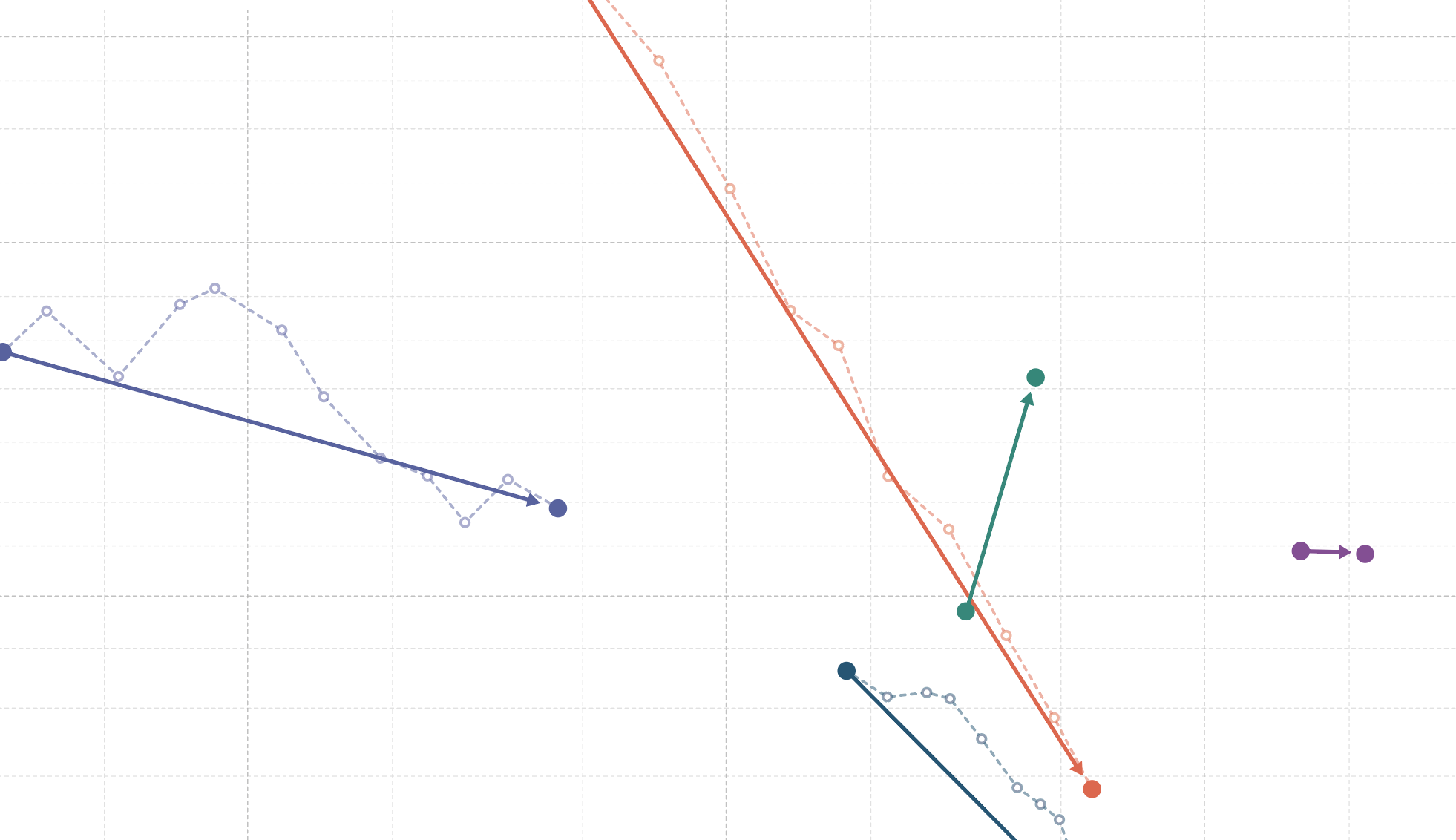
Why did renewables become so cheap so fast?
In most places power from new renewables is now cheaper than new fossil fuels.

The brief history of artificial intelligence: the world has changed fast — what might be next?
Little is as important for the world’s future and our own lives as how this history continues.

Yields vs. land use: how the Green Revolution enabled us to feed a growing population
Crop yields across the world have increased dramatically over the last half-century. But has this kept up with a growing population?
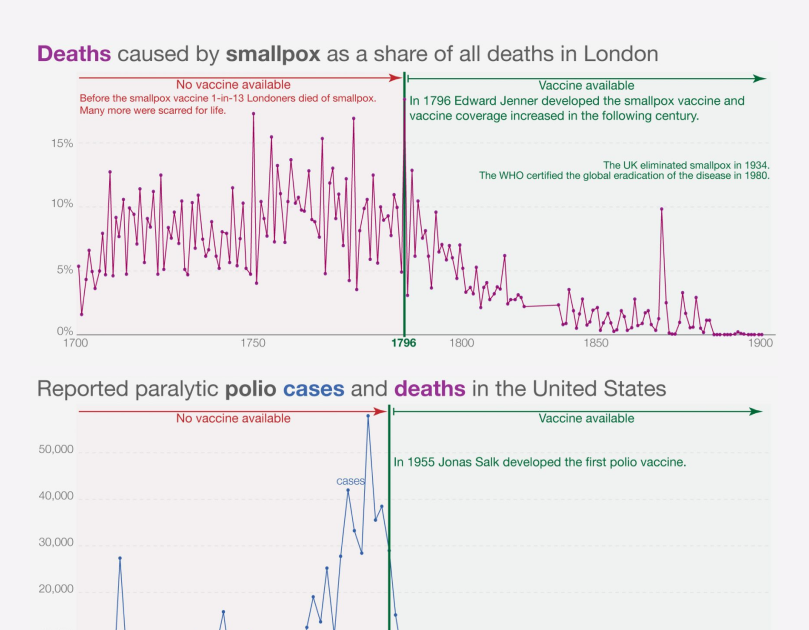
Our history is a battle against the microbes: we lost terribly before science, public health, and vaccines allowed us to protect ourselves
For most of our history, we were losing terribly against the microbes. Only recently did we turn the battle in our favor. Vaccines were a major breakthrough.

Antiretroviral therapy has saved millions of lives from AIDS and could save more
38 million people had HIV/AIDS in 2020. A couple of decades ago, the chances of surviving more than ten years with HIV were slim. Today, thanks to antiretroviral therapy (ART), people with HIV/AIDS can expect to live long lives. How many lives has ART saved?
Bernadeta Dadonaite
Interactive Charts on Research and Development
Cite this work.
Our articles and data visualizations rely on work from many different people and organizations. When citing this topic page, please also cite the underlying data sources. This topic page can be cited as:
BibTeX citation
Reuse this work freely
All visualizations, data, and code produced by Our World in Data are completely open access under the Creative Commons BY license . You have the permission to use, distribute, and reproduce these in any medium, provided the source and authors are credited.
The data produced by third parties and made available by Our World in Data is subject to the license terms from the original third-party authors. We will always indicate the original source of the data in our documentation, so you should always check the license of any such third-party data before use and redistribution.
All of our charts can be embedded in any site.
Our World in Data is free and accessible for everyone.
Help us do this work by making a donation.

In order to continue enjoying our site, we ask that you confirm your identity as a human. Thank you very much for your cooperation.
Have a language expert improve your writing
Run a free plagiarism check in 10 minutes, generate accurate citations for free.
- Knowledge Base
Methodology
- What Is a Research Design | Types, Guide & Examples
What Is a Research Design | Types, Guide & Examples
Published on June 7, 2021 by Shona McCombes . Revised on November 20, 2023 by Pritha Bhandari.
A research design is a strategy for answering your research question using empirical data. Creating a research design means making decisions about:
- Your overall research objectives and approach
- Whether you’ll rely on primary research or secondary research
- Your sampling methods or criteria for selecting subjects
- Your data collection methods
- The procedures you’ll follow to collect data
- Your data analysis methods
A well-planned research design helps ensure that your methods match your research objectives and that you use the right kind of analysis for your data.
Table of contents
Step 1: consider your aims and approach, step 2: choose a type of research design, step 3: identify your population and sampling method, step 4: choose your data collection methods, step 5: plan your data collection procedures, step 6: decide on your data analysis strategies, other interesting articles, frequently asked questions about research design.
- Introduction
Before you can start designing your research, you should already have a clear idea of the research question you want to investigate.
There are many different ways you could go about answering this question. Your research design choices should be driven by your aims and priorities—start by thinking carefully about what you want to achieve.
The first choice you need to make is whether you’ll take a qualitative or quantitative approach.
| Qualitative approach | Quantitative approach |
|---|---|
| and describe frequencies, averages, and correlations about relationships between variables |
Qualitative research designs tend to be more flexible and inductive , allowing you to adjust your approach based on what you find throughout the research process.
Quantitative research designs tend to be more fixed and deductive , with variables and hypotheses clearly defined in advance of data collection.
It’s also possible to use a mixed-methods design that integrates aspects of both approaches. By combining qualitative and quantitative insights, you can gain a more complete picture of the problem you’re studying and strengthen the credibility of your conclusions.
Practical and ethical considerations when designing research
As well as scientific considerations, you need to think practically when designing your research. If your research involves people or animals, you also need to consider research ethics .
- How much time do you have to collect data and write up the research?
- Will you be able to gain access to the data you need (e.g., by travelling to a specific location or contacting specific people)?
- Do you have the necessary research skills (e.g., statistical analysis or interview techniques)?
- Will you need ethical approval ?
At each stage of the research design process, make sure that your choices are practically feasible.
Receive feedback on language, structure, and formatting
Professional editors proofread and edit your paper by focusing on:
- Academic style
- Vague sentences
- Style consistency
See an example

Within both qualitative and quantitative approaches, there are several types of research design to choose from. Each type provides a framework for the overall shape of your research.
Types of quantitative research designs
Quantitative designs can be split into four main types.
- Experimental and quasi-experimental designs allow you to test cause-and-effect relationships
- Descriptive and correlational designs allow you to measure variables and describe relationships between them.
| Type of design | Purpose and characteristics |
|---|---|
| Experimental | relationships effect on a |
| Quasi-experimental | ) |
| Correlational | |
| Descriptive |
With descriptive and correlational designs, you can get a clear picture of characteristics, trends and relationships as they exist in the real world. However, you can’t draw conclusions about cause and effect (because correlation doesn’t imply causation ).
Experiments are the strongest way to test cause-and-effect relationships without the risk of other variables influencing the results. However, their controlled conditions may not always reflect how things work in the real world. They’re often also more difficult and expensive to implement.
Types of qualitative research designs
Qualitative designs are less strictly defined. This approach is about gaining a rich, detailed understanding of a specific context or phenomenon, and you can often be more creative and flexible in designing your research.
The table below shows some common types of qualitative design. They often have similar approaches in terms of data collection, but focus on different aspects when analyzing the data.
| Type of design | Purpose and characteristics |
|---|---|
| Grounded theory | |
| Phenomenology |
Your research design should clearly define who or what your research will focus on, and how you’ll go about choosing your participants or subjects.
In research, a population is the entire group that you want to draw conclusions about, while a sample is the smaller group of individuals you’ll actually collect data from.
Defining the population
A population can be made up of anything you want to study—plants, animals, organizations, texts, countries, etc. In the social sciences, it most often refers to a group of people.
For example, will you focus on people from a specific demographic, region or background? Are you interested in people with a certain job or medical condition, or users of a particular product?
The more precisely you define your population, the easier it will be to gather a representative sample.
- Sampling methods
Even with a narrowly defined population, it’s rarely possible to collect data from every individual. Instead, you’ll collect data from a sample.
To select a sample, there are two main approaches: probability sampling and non-probability sampling . The sampling method you use affects how confidently you can generalize your results to the population as a whole.
| Probability sampling | Non-probability sampling |
|---|---|
Probability sampling is the most statistically valid option, but it’s often difficult to achieve unless you’re dealing with a very small and accessible population.
For practical reasons, many studies use non-probability sampling, but it’s important to be aware of the limitations and carefully consider potential biases. You should always make an effort to gather a sample that’s as representative as possible of the population.
Case selection in qualitative research
In some types of qualitative designs, sampling may not be relevant.
For example, in an ethnography or a case study , your aim is to deeply understand a specific context, not to generalize to a population. Instead of sampling, you may simply aim to collect as much data as possible about the context you are studying.
In these types of design, you still have to carefully consider your choice of case or community. You should have a clear rationale for why this particular case is suitable for answering your research question .
For example, you might choose a case study that reveals an unusual or neglected aspect of your research problem, or you might choose several very similar or very different cases in order to compare them.
Data collection methods are ways of directly measuring variables and gathering information. They allow you to gain first-hand knowledge and original insights into your research problem.
You can choose just one data collection method, or use several methods in the same study.
Survey methods
Surveys allow you to collect data about opinions, behaviors, experiences, and characteristics by asking people directly. There are two main survey methods to choose from: questionnaires and interviews .
| Questionnaires | Interviews |
|---|---|
| ) |
Observation methods
Observational studies allow you to collect data unobtrusively, observing characteristics, behaviors or social interactions without relying on self-reporting.
Observations may be conducted in real time, taking notes as you observe, or you might make audiovisual recordings for later analysis. They can be qualitative or quantitative.
| Quantitative observation | |
|---|---|
Other methods of data collection
There are many other ways you might collect data depending on your field and topic.
| Field | Examples of data collection methods |
|---|---|
| Media & communication | Collecting a sample of texts (e.g., speeches, articles, or social media posts) for data on cultural norms and narratives |
| Psychology | Using technologies like neuroimaging, eye-tracking, or computer-based tasks to collect data on things like attention, emotional response, or reaction time |
| Education | Using tests or assignments to collect data on knowledge and skills |
| Physical sciences | Using scientific instruments to collect data on things like weight, blood pressure, or chemical composition |
If you’re not sure which methods will work best for your research design, try reading some papers in your field to see what kinds of data collection methods they used.
Secondary data
If you don’t have the time or resources to collect data from the population you’re interested in, you can also choose to use secondary data that other researchers already collected—for example, datasets from government surveys or previous studies on your topic.
With this raw data, you can do your own analysis to answer new research questions that weren’t addressed by the original study.
Using secondary data can expand the scope of your research, as you may be able to access much larger and more varied samples than you could collect yourself.
However, it also means you don’t have any control over which variables to measure or how to measure them, so the conclusions you can draw may be limited.
Here's why students love Scribbr's proofreading services
Discover proofreading & editing
As well as deciding on your methods, you need to plan exactly how you’ll use these methods to collect data that’s consistent, accurate, and unbiased.
Planning systematic procedures is especially important in quantitative research, where you need to precisely define your variables and ensure your measurements are high in reliability and validity.
Operationalization
Some variables, like height or age, are easily measured. But often you’ll be dealing with more abstract concepts, like satisfaction, anxiety, or competence. Operationalization means turning these fuzzy ideas into measurable indicators.
If you’re using observations , which events or actions will you count?
If you’re using surveys , which questions will you ask and what range of responses will be offered?
You may also choose to use or adapt existing materials designed to measure the concept you’re interested in—for example, questionnaires or inventories whose reliability and validity has already been established.
Reliability and validity
Reliability means your results can be consistently reproduced, while validity means that you’re actually measuring the concept you’re interested in.
| Reliability | Validity |
|---|---|
| ) ) |
For valid and reliable results, your measurement materials should be thoroughly researched and carefully designed. Plan your procedures to make sure you carry out the same steps in the same way for each participant.
If you’re developing a new questionnaire or other instrument to measure a specific concept, running a pilot study allows you to check its validity and reliability in advance.
Sampling procedures
As well as choosing an appropriate sampling method , you need a concrete plan for how you’ll actually contact and recruit your selected sample.
That means making decisions about things like:
- How many participants do you need for an adequate sample size?
- What inclusion and exclusion criteria will you use to identify eligible participants?
- How will you contact your sample—by mail, online, by phone, or in person?
If you’re using a probability sampling method , it’s important that everyone who is randomly selected actually participates in the study. How will you ensure a high response rate?
If you’re using a non-probability method , how will you avoid research bias and ensure a representative sample?
Data management
It’s also important to create a data management plan for organizing and storing your data.
Will you need to transcribe interviews or perform data entry for observations? You should anonymize and safeguard any sensitive data, and make sure it’s backed up regularly.
Keeping your data well-organized will save time when it comes to analyzing it. It can also help other researchers validate and add to your findings (high replicability ).
On its own, raw data can’t answer your research question. The last step of designing your research is planning how you’ll analyze the data.
Quantitative data analysis
In quantitative research, you’ll most likely use some form of statistical analysis . With statistics, you can summarize your sample data, make estimates, and test hypotheses.
Using descriptive statistics , you can summarize your sample data in terms of:
- The distribution of the data (e.g., the frequency of each score on a test)
- The central tendency of the data (e.g., the mean to describe the average score)
- The variability of the data (e.g., the standard deviation to describe how spread out the scores are)
The specific calculations you can do depend on the level of measurement of your variables.
Using inferential statistics , you can:
- Make estimates about the population based on your sample data.
- Test hypotheses about a relationship between variables.
Regression and correlation tests look for associations between two or more variables, while comparison tests (such as t tests and ANOVAs ) look for differences in the outcomes of different groups.
Your choice of statistical test depends on various aspects of your research design, including the types of variables you’re dealing with and the distribution of your data.

Qualitative data analysis
In qualitative research, your data will usually be very dense with information and ideas. Instead of summing it up in numbers, you’ll need to comb through the data in detail, interpret its meanings, identify patterns, and extract the parts that are most relevant to your research question.
Two of the most common approaches to doing this are thematic analysis and discourse analysis .
| Approach | Characteristics |
|---|---|
| Thematic analysis | |
| Discourse analysis |
There are many other ways of analyzing qualitative data depending on the aims of your research. To get a sense of potential approaches, try reading some qualitative research papers in your field.
If you want to know more about the research process , methodology , research bias , or statistics , make sure to check out some of our other articles with explanations and examples.
- Simple random sampling
- Stratified sampling
- Cluster sampling
- Likert scales
- Reproducibility
Statistics
- Null hypothesis
- Statistical power
- Probability distribution
- Effect size
- Poisson distribution
Research bias
- Optimism bias
- Cognitive bias
- Implicit bias
- Hawthorne effect
- Anchoring bias
- Explicit bias
A research design is a strategy for answering your research question . It defines your overall approach and determines how you will collect and analyze data.
A well-planned research design helps ensure that your methods match your research aims, that you collect high-quality data, and that you use the right kind of analysis to answer your questions, utilizing credible sources . This allows you to draw valid , trustworthy conclusions.
Quantitative research designs can be divided into two main categories:
- Correlational and descriptive designs are used to investigate characteristics, averages, trends, and associations between variables.
- Experimental and quasi-experimental designs are used to test causal relationships .
Qualitative research designs tend to be more flexible. Common types of qualitative design include case study , ethnography , and grounded theory designs.
The priorities of a research design can vary depending on the field, but you usually have to specify:
- Your research questions and/or hypotheses
- Your overall approach (e.g., qualitative or quantitative )
- The type of design you’re using (e.g., a survey , experiment , or case study )
- Your data collection methods (e.g., questionnaires , observations)
- Your data collection procedures (e.g., operationalization , timing and data management)
- Your data analysis methods (e.g., statistical tests or thematic analysis )
A sample is a subset of individuals from a larger population . Sampling means selecting the group that you will actually collect data from in your research. For example, if you are researching the opinions of students in your university, you could survey a sample of 100 students.
In statistics, sampling allows you to test a hypothesis about the characteristics of a population.
Operationalization means turning abstract conceptual ideas into measurable observations.
For example, the concept of social anxiety isn’t directly observable, but it can be operationally defined in terms of self-rating scores, behavioral avoidance of crowded places, or physical anxiety symptoms in social situations.
Before collecting data , it’s important to consider how you will operationalize the variables that you want to measure.
A research project is an academic, scientific, or professional undertaking to answer a research question . Research projects can take many forms, such as qualitative or quantitative , descriptive , longitudinal , experimental , or correlational . What kind of research approach you choose will depend on your topic.
Cite this Scribbr article
If you want to cite this source, you can copy and paste the citation or click the “Cite this Scribbr article” button to automatically add the citation to our free Citation Generator.
McCombes, S. (2023, November 20). What Is a Research Design | Types, Guide & Examples. Scribbr. Retrieved June 17, 2024, from https://www.scribbr.com/methodology/research-design/
Is this article helpful?
Shona McCombes
Other students also liked, guide to experimental design | overview, steps, & examples, how to write a research proposal | examples & templates, ethical considerations in research | types & examples, what is your plagiarism score.

- FlashLine Login
- Phone Directory
- Maps & Directions
- Ensuring High Quality Proposals
- Supporting Your Students
- Faculty Recognition
- Workshops, Forums, and Brown Bags
- Limited Submission Programs
- Open Access Publishing Fund
What is Research Development?
The National Organization of Research Development Professionals (NORDP) defines the goal of Research Development offices as supporting the efforts of faculty to secure extramural research funding and initiate and nurture critical partnerships throughout the institutional research enterprise, among institutions, and with external stakeholders. Research Development is often likened to a PRE-, pre-award office, in that while a Research Administration office provides pre- and post-award services for grants, a Research Development office works with faculty to build teams, catalyze collaborations, and aid in the preparation of a proposal. In general, the manner in which Research Administration and Research Development works together is best displayed by this Venn diagram:

The Office of Research Faculty Development at Kent State University is heavily invested in ensuring the success of our faculty engaged in research and scholarly pursuits. Whether you are new to seeking funding for your research or are a seasoned investigator, programming through the Office of Research Faculty Development can aid you in identifying potential collaborators, building a research team, and developing the best possible grant application. We work with faculty one-on-one and offer workshops throughout the year. We also sponsor a number of networking activities so that you can meet your colleagues at Kent State and the surrounding region. Please do not hesitate to contact us if we can aid you in your research endeavors.
Street Address
Mailing address.
- 330-672-3000
- [email protected]
- Kent State Kent Campus - facebook
- Kent State Kent Campus - twitter
- Kent State Kent Campus - youtube
- Kent State Kent Campus - instagram
- Kent State Kent Campus - linkedin
- Kent State Kent Campus - snapchat
- Kent State Kent Campus - pinterest
- Accessibility
- Annual Security Reports
- Emergency Information
- For Our Alumni
- For the Media
- Health Services
- Jobs & Employment
- Privacy Statement
- HEERF CARES/CRRSAA/ARP Act Reporting and Disclosure
- Website Feedback

Virtual Tour
Experience University of Idaho with a virtual tour. Explore now
- Discover a Career
- Find a Major
- Experience U of I Life
More Resources
- Admitted Students
- International Students
Take Action
- Find Financial Aid
- View Deadlines
- Find Your Rep

Helping to ensure U of I is a safe and engaging place for students to learn and be successful. Read about Title IX.
Get Involved
- Clubs & Volunteer Opportunities
- Recreation and Wellbeing
- Student Government
- Student Sustainability Cooperative
- Academic Assistance
- Safety & Security
- Career Services
- Health & Wellness Services
- Register for Classes
- Dates & Deadlines
- Financial Aid
- Sustainable Solutions
- U of I Library

- Upcoming Events
Review the events calendar.
Stay Connected
- Vandal Family Newsletter
- Here We Have Idaho Magazine
- Living on Campus
- Campus Safety
- About Moscow

The largest Vandal Family reunion of the year. Check dates.
Benefits and Services
- Vandal Voyagers Program
- Vandal License Plate
- Submit Class Notes
- Make a Gift
- View Events
- Alumni Chapters
- University Magazine
- Alumni Newsletter

U of I's web-based retention and advising tool provides an efficient way to guide and support students on their road to graduation. Login to VandalStar.
Common Tools
- Administrative Procedures Manual (APM)
- Class Schedule
- OIT Tech Support
- Academic Dates & Deadlines
- U of I Retirees Association
- Faculty Senate
- Staff Council
- License Technology
- Research Compliance Issue
- Fund a research project
- Manage a Sponsored Project

Parasite Uptick
Some Idaho Moose Infested with Winter Ticks

Design. Print. Build.
Building Affordable Houses With Wood Waste

Education Inequalities
"The Vandal Theory" Interviews Krista Soria

Finding Joy in Sports
Is it possible to learn to love running?
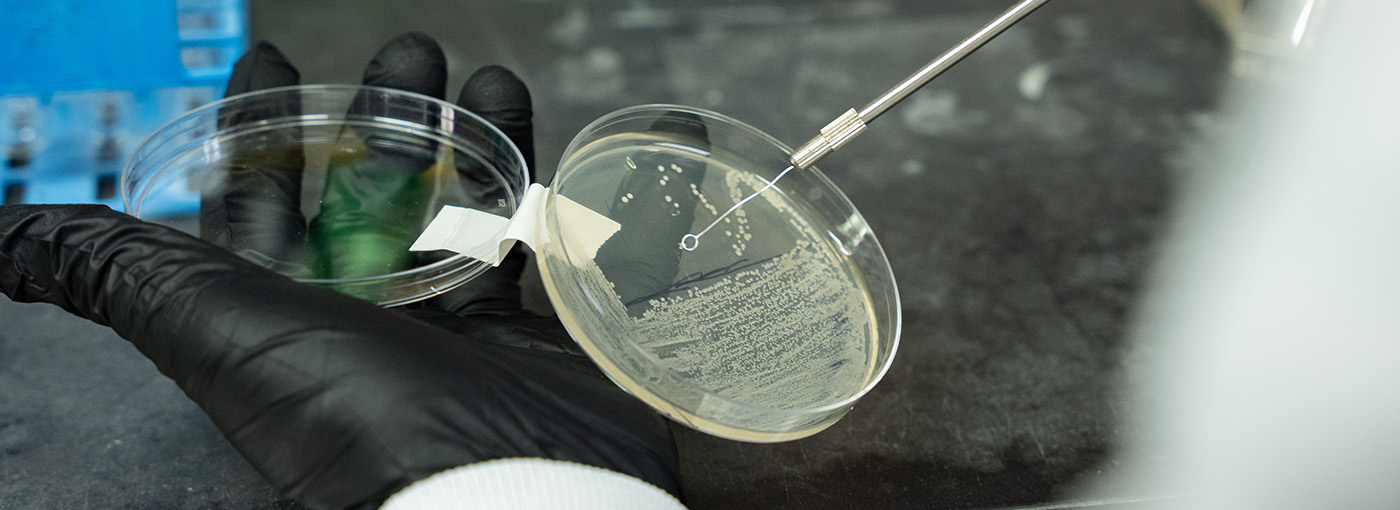
Sustainable Science Innovations
U of I Leads Systemic Sustainability Research Efforts

Multimedia Boosts Learning
Professor Uses Visual Slides to Enhance Medical Education

Living Archives
Advancing Natural Resource Archives and Accessibility

Lampreys Return
Ensuring Pacific Lampreys Reach Spawning Grounds
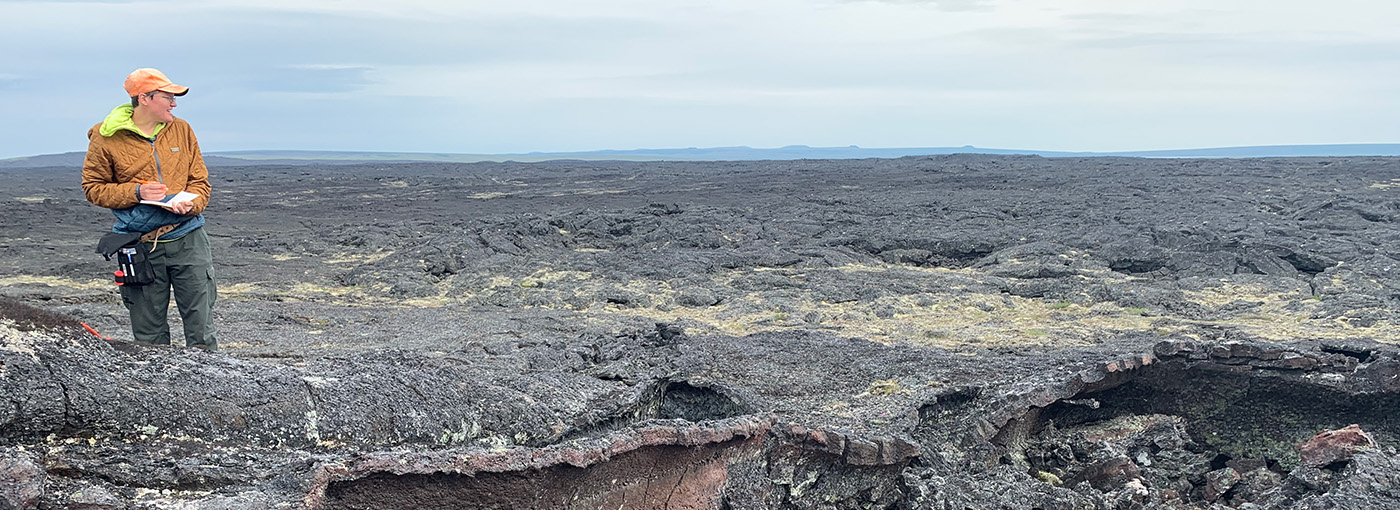
Mars to Minecraft
"The Vandal Theory" Interviews Erika Rader
Office of Research & Economic Development
Physical Address: Morrill Hall 105
Mailing Address: 875 Perimeter Drive MS 3010 University of Idaho Moscow, ID 83844-3010
Phone: 208-885-5663
Email: [email protected]
Research and Faculty Development
Phone: 208-885-1144
Email: [email protected]
Web: Office of Research and Faculty Development
Office of Research Assurances
Morrill Hall Room 414 Moscow, ID 83844
Mailing Address: 875 Perimeter Dr., MS 3010 Moscow, ID 83844-3010
Phone: 208-885-2258
Email: [email protected]
Web: ORA Website
Office of Sponsored Programs
Morrill Hall Room 209 Moscow, ID 83843
Mailing Address: 875 Perimeter Dr., MS 3020 Moscow, ID 83844-3020
Phone: 208-885-6651
Fax: 208-885-4990
Email: [email protected]
Web: OSP Website
Office of Technology Transfer - Moscow
Physical Address: Morrill Hall 105 Moscow, ID 83844-3003
Mailing Address: 875 Perimeter Drive MS 3003 Moscow, ID 83844-3003
Email: [email protected]
We seek to make discoveries. That mission has defined the University of Idaho since our founding in 1889 and not only propels us forward but defines our research efforts in the present.
Today, as Idaho’s land-grant university , our cross-disciplinary research serves communities across the state and beyond — from improving health outcomes to making local business more sustainable to advancing technological developments and creative pursuits.
Learn more about our approach, vision and ways you can get involved.
About Research at U of I
U of I is classified by the Carnegie Foundation as a High Research Activity university. We expend over $135.9 million in research dollars annually — top among public universities in Idaho.
Research Highlights FY23
Total Awards
Annual Research Expenditures
Invention Disclosures
Patent Applications
The Office of Research and Economic Development (ORED) enables, supports, performs and promotes research, scholarly and creative activities that address the needs and expectations of the state, region and world.
ORED partners with faculty, students and staff to support their creation of new knowledge, to promote the use of this knowledge and to ensure its integrity.
Our vision is that U of I activities will expand knowledge, provide solutions, foster an enhanced quality of life and cultivate an educated 21st century citizenry. Learn more about our approach, mission, team and funding .
Information and Resources
ORED connects businesses and industries with university researchers who can assist them in answering questions and solving problems. Through technology transfer, U of I discoveries are licensed to companies and launched as startups.
The office also encourages out-of-the-classroom research and scholarly and creative experiences that will expand both undergraduate and graduate students’ minds and give them the skills they need to be successful in their future careers.
Explore all resources for students, faculty and staff, and business and industry partnerships below.
For Faculty and Staff
All about applying for and managing grants, licensing your technology, conducting safe and ethical research and more.
For Students
How students can participate in research projects and promote their results.
For Business and Industry
License university technology, fund a program and other resources for business and industry.
Our Research Approach
We aim to break boundaries. This mindset shapes our academic programs, as well as multidisciplinary research bridging departments and colleges and involving collaborating organizations, businesses and industries.
We approach research through a sense of discovery, with the goal of advancing our world — from how our society functions to the ways businesses impact the environment. We don’t go about this alone: We’ve developed partnerships with other agencies that fund our research and allow our insights to have an effect beyond campus. Our work contributes to scientific innovation and provides businesses and organizations, including the USDA and Columbia River Inter-Tribal Fishing Commission, with data for enacting change.
We often start with a question and consider new, different solutions to formulate an answer. We also observe challenges in our own backyard — from water quality to land management to agricultural processes — and the rippling effect they have across the globe.
With this purpose, our research helps:
- increase awareness and understanding of certain diseases;
- strengthen crops and improve land and water use in agriculture;
- address our changing climate and create a more sustainable human ecosystem;
- improve food safety;
- grow our understanding of how humans interact with technology;
- apply evolutionary and computational biology to enhance human wellbeing and address agricultural concerns;
- survey and map the region’s geologic features;
- explore applications of data analytics and data science;
- spur creative and scholarly projects in the humanities, social sciences and performing arts; and
- advance the state’s agricultural efforts and natural resource conservation, including through or in conjunction with the Aquaculture Research Institute , Idaho Water Resources Research Institute and the Center for Advanced Energy Studies .
We offer opportunities to students striving to make a difference and gain experience to jumpstart their careers. Two-thirds of undergraduate students and all our graduate students participate in research.
Along with faculty-led and organization-sponsored programs, the Integrated Research and Innovation Center’s flexible, modular environment helps get ideas off the ground. The MILL at the U of I Library lets students familiarize themselves with the latest technologies, including 3-D printing and audio and video production.
Learn more about our research entities and initiatives .
Meet Our People
Our Technologies
We’re always thinking ahead and ready to forge a new path. A broad spectrum of technologies guides our efforts:
- optical imaging;
- computing and data analysis;
- materials fabrication and characterization;
- equipment for genomics and DNA analysis;
- animal care and holding rooms; and
- mass spectrometry and nuclear magnetic resonance spectroscopy.
Learn more about our technological capabilities and facilities .
Learn More About Research at U of I
Interested in learning more, or have additional questions about our research programs? Reach out to the Office of Research and Economic Development by email or by phone at 208-885-6689 today.
An official website of the United States government
Here’s how you know
Official websites use .gov A .gov website belongs to an official government organization in the United States.
Secure .gov websites use HTTPS A lock ( Lock Locked padlock icon ) or https:// means you’ve safely connected to the .gov website. Share sensitive information only on official, secure websites.
- Entire Site
- Research & Funding
- Health Information
- About NIDDK
Research & Funding
NIDDK conducts and supports innovative and pivotal basic, clinical, and translational research while fostering research training and mentoring opportunities to create new knowledge and improve health.
Current Funding Opportunities
Open Notices of Funding Opportunities (NOFOs) including RFAs and PAs with NIDDK contacts.
Research Programs & Contacts
Learn about research goals and speak to someone about opportunities in your research area. NIDDK research funding programs and centers are organized by disease area.
Research at NIDDK
- Laboratories & Branches
- Training & Employment
Human Subjects Research
NIDDK provides funding for pivotal clinical research, from preliminary clinical feasibility to large multi-center studies.
Funding Process
- Award Funding Policy
- Grant Review
- Grants Management
Research Training & Career Development
- Eligibility by Career Level
- Frequently Asked Questions
Funded Grants & Grant History
- Funding Trends & Support of Guiding Principles
- Funded Grants
- Success Rates
Research Resources
Access NIDDK-supported data sets, protocols, and services including technology transfer.
Technology Advancement
- Research Materials Transfer & Licensing
- Clinical Trial Collaboration
- Research Collaboration
Additional Research Programs
Research training.
NIDDK supports the training and career development of medical and graduate students, postdoctoral fellows, and physician scientists through institutional and individual grants.
Diversity Programs
The NIDDK offers and participates in a variety of opportunities for trainees and researchers from communities underrepresented in the biomedical research enterprise. These opportunities include travel and scholarship awards, research supplements, small clinical grants, high school and undergraduate programs, and a network of minority health research investigators.
Small Business
Small business programs.
NIDDK participates in the Small Business Innovation Research (SBIR) and Small Business Technology Transfer (STTR) programs. These programs support innovative research conducted by small businesses that has the potential for commercialization.
Translational Research
NIDDK provides funding opportunities and resources to encourage translation of basic discoveries into novel therapeutics.
Meetings & Workshops

June 17, 2024 Webinar
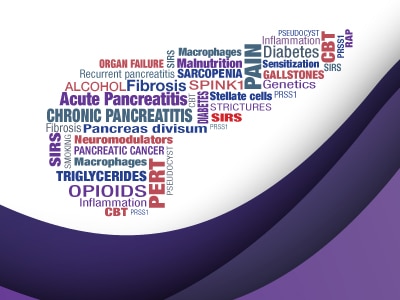
July 24, 2024 Cincinnati, OH Webinar

July 31 - Aug. 2, 2024 Charlottesville, VA

Sept. 5 - 6, 2024 Bethesda, MD Webinar

Sept. 27, 2024 Bethesda, MD Webinar

Oct. 10 - 11, 2024 Bethesda, MD Webinar

Research, Society and Development
About the journal.
The Research, Society and Development journal (whose abbreviated title is Res., Soc. Dev.) is a multidisciplinary scientific publication focused on promoting the social, scientific and technological development through the publication of the findings that have occurred in different areas. This is a monthly journal, which publishes various types of manuscript, such as scientific articles, reviews and case teaching in diversified areas of knowledge. The journal receives many contributions in Portuguese, or English or Spanish, (or other language on request) from researchers in the area of Teaching, which allows to evaluate and publish also educational objects.
Ad hoc revisors 2023
We thank all of the more than 325 “ad hoc” reviewers who contributed to this Journal (double-blind peer review) during the year 2023.
Reviewers 2023
Current Issue

JOURNAL METRICS
Índice H5 (Google Metrics): 28 (2023)
Score CiteFactor: 1.78 (2020-21)
- Español (España)
- Português (Brasil)
Make a Submission
Base de Dados e Indexadores: Base , Diadorim , Sumarios.org , DOI Crossref , Dialnet , Scholar Google , Redib , Latindex
Research, Society and Development - ISSN 2525-3409

CDRR Editors. Avenida Sulim Abramovitc, 100 - Centro, Vargem Grande Paulista - SP, 06730-000 E-mail: [email protected] |

An official website of the United States government
The .gov means it’s official. Federal government websites often end in .gov or .mil. Before sharing sensitive information, make sure you’re on a federal government site.
The site is secure. The https:// ensures that you are connecting to the official website and that any information you provide is encrypted and transmitted securely.
- Publications
- Account settings
Preview improvements coming to the PMC website in October 2024. Learn More or Try it out now .
- Advanced Search
- Journal List
- Springer Nature - PMC COVID-19 Collection

Russian Science and Technology: Rise or Progressive Lag (Part I)
A. n. klepach.
1 Institute of Economic Forecasting, Russian Academy of Sciences, Moscow, Russia
L. B. Vodovatov
2 Research and Expert Review Institute, Vnesheconombank of the Russian Federation, Moscow, Russia
E. A. Dmitrieva
The article proposes an approach to a comprehensive assessment of the level of scientific and technological activity in Russia in comparison with leading foreign countries. An analysis has been made of the current imbalances in the development of the scientific and technological sphere in Russia and the reasons for the failure to fulfill many strategic goals. A forecast of scientific and technological development in the context of the existing management system has been made and an assessment has been taken of the potential effect and cost of measures aimed at increasing the technological sovereignty of Russia and the formation of an advanced knowledge economy.
Introduction. Almost all countries and experts consider science and technology to be the main driver of modern development. In Russia, science employs almost 0.8% of all those working in the national economy and creates 1.4% of GDP. This is not much, but the overall contribution of science and technology to the development of the Russian economy is many times higher. However, despite certain positive results, in general, the sphere of technological development and especially science is, in our opinion, the Achilles’ heel of the modern Russian economy. In fact, the main achievements in this area include the following:
— In the field of innovation, a system of technological and venture development institutions has been created: Rosnano, NTI, Skolkovo, RVC, the Foundation for Assistance to the Development of Small Forms of Enterprises in the Scientific and Technological Sphere (FSI) and a number of other funds.
— Funding for megascience class installations (national project Science and Universities) was increased, a grant system to support scientists and projects was created.
— In 2013–2020, there was an increase in the level of wages in the scientific sector in relation to the corporate sector, an influx of young scientists and researchers increased.
— There are separate breakthrough technological results (nanotubes, vaccines, composites, supercomputers and works on artificial intelligence, nuclear technologies and lasers, hypersound).
— Publication activity of scientists increased.
At the same time, Russia is lagging behind developed countries in terms of R&D funding [ 1 ], patent and publication activity, and the number of research personnel is declining. Most target indicators of the Decrees of the President of the Russian Federation of 2012 and 2018 1 for the development of the sphere of science and technology, except for the task of raising wages, have not been fulfilled ( Table 1 ).
Table 1.
Results of the implementation of strategic documents for the development of science and technology
| Strategic documents | Indicators | Forecast value (estimate) | Year of achievement | Russia 2020 (fact) |
|---|---|---|---|---|
Concept of Long-Term Socio-Economic Development of Russia until 2020 and Strategy for Innovative Development of Russia 2020 | Research and development expenses, in % of GDP | 2.5–3 | 2020 | 1.1 |
| Share of industrial enterprises implementing technological innovations, % | 40–50 | 21.5* | ||
| Share of innovative products, % | 25–30 | 5.7 |
* In 2020, the share of organizations implementing technological innovations increased to 23% (up to 21.5% in industry). This growth is associated with a change in international recommendations on the statistical measurement of innovation, implemented by the OECD together with Eurostat (Oslo Manual). The value of the indicator for the Russian Federation for 2017, calculated according to the criteria of the 3rd edition of the Oslo Manual, amounted to 7.5%, when recalculated according to the criteria of the 4th edition of the Oslo Manual, it increased to 20.8%. The difference in the calculation is due to the use of three criteria for classifying an organization as innovative instead of one.
In the Concept of Long-Term Socio-Economic Development until 2020 (CLTD) 2 adopted by the Government of the Russian Federation in 2008, the task of Russia’s transition to the innovative development of the economy was set. In 2011, the Innovative Development Strategy was adopted, the purpose of which was to increase the innovative activity of business and the efficiency of the transformation of scientific ideas into technologies and market innovations, a state program for the development of science and technology was initiated, as well as a number of other decisions.
However, most of the targets of the CLTD-2020 and the Innovation Development Strategy were not achieved. In particular, domestic expenditures on R&D were planned in 2020 at the level of 3% of GDP, but in fact amounted to only 1.1%. Actually, the indicator of R&D expenses relative to GDP (1%) has been stagnating for almost 13 years. The problems that had accumulated over the years sharply escalated under the conditions of the hybrid war launched by the West against Russia, including actions to isolate the Russian scientific community from world science and a technological blockade.
What resources does Russia have in this war of minds and technologies, and how should the management of the scientific and technological complex be restructured in order to win and lift the country?
Comparative potential and effectiveness of the scientific and technological complex of Russia and other countries: relative and absolute dimensions. If in 2008 we were approximately on the same level with China in terms of the relative level of R&D expenses, now China has increased spending to 2.4% of GDP, despite the fact that its GDP is 5.5 times higher than in Russia ( Table 2 ). In the United States, R&D expenses are 3.4% of GDP, in South Korea 4.8% of GDP. Although Russia now ranks 9th in the world in terms of R&D expenses (in terms of purchasing power parity), it is 12.1 times behind China and 15 times behind the United States, and there are all the prerequisites for this gap to widen [ 2 ]. In the context of fierce technological rivalry and the hybrid war unleashed against Russia by the collective West, such an imbalance in power becomes threatening.
Table 2.
Comparative global dynamics of R&D expenses
| Country | R&D expenditures based on PPP, billion dollars | R&D expenses, % of GDP | Including government R&D expenses, % of GDP | |||
|---|---|---|---|---|---|---|
| 2008 | 2020 | 2008 | 2020 | 2008 | 2020 | |
| Israel | 8.7 | 19.8 | 4.3 | 5.44 | 0.5 | 0.5 |
| Republic of Korea | 43.9 | 112.9 | 3.0 | 4.81 | 0.8 | 1.1 |
| USA | 407.2 | 720.8 | 2.8 | 3.45 | 0.8 | 0.7 |
| Japan | 148.7 | 174.1 | 3.3 | 3.3 | 0.5 | 0.5 |
| Germany | 81.2 | 143.4 | 2.6 | 3.14 | 0.7 | 0.9 |
| China | 145.1 | 582.8 | 1.4 | 2.4 | 0.3 | 0.5 |
| France | 46.6 | 74.6 | 2.1 | 2.35 | 0.8 | 0.7 |
| Great Britain | 36.5 | 56.9 | 1.6 | 1.7 | 0.5 | 0.5 |
| Czech Republic | 3.6 | 8.9 | 1.2 | 1.9 | 0.6 | 0.7 |
| Russia | 30.1 | 47.9 | 0.97 | 1.1 | 0.6 | 0.7 |
Source: OECD, UK (PPP R&D expenses) 2019, Israel, Germany, France (Public R&D expenses, % of GDP) 2019.
If we evaluate R&D expenses taking into account the number of researchers, then the situation in Russia will be even less optimistic: in 2019, 1 researcher (in full-time equivalent) accounted for 3.5 times less research and development expenses than in the United States, and three times less than in Germany. According to this indicator, Russia occupies only 44th place 3 ( Table 3 ).
Table 3.
Place of Russia among the leading countries of the world
| Country | R&D employees by country: 2020 (thousand person-years, full-time equivalent) | Country | Number of researchers by country: 2020* (thousand person-years, full-time equivalent) | Country | Domestic R&D expenses by country: 2020 billion dollars in terms of PPP | |
|---|---|---|---|---|---|---|
| 1 | China | 4800.8 | China | 2109.5 | USA | 657.5 |
| 2 | USA | 1554.9 | USA | 1554.9 | China | 525.7 |
| 3 | Japan | 903.4 | Japan | 681.8 | Japan | 173.3 |
| 4 | Russia | 748.7 | Germany | 450.7 | Germany | 148.1 |
| 5 | Germany | 735.6 | Republic of Korea | 430.7 | Republic of Korea | 102.5 |
| 6 | India | 553.0 | Russia | 397.2 | France | 73.3 |
| 7 | Republic of Korea | 525.7 | India | 341.8 | India | 58.7 |
| 8 | Great Britain | 486.1 | Great Britain | 317.5 | Great Britain | 56.9 |
| 9 | France | 463.7 | France | 314.1 | Russia | 45.4 |
| 10 | Italy | 355.9 | Brazil | 180.0 | Taiwan | 44.0 |
| 11 | Brazil | 316.5 | Canada | 167.4 | Italy | 39.3 |
| 12 | Taiwan | 271.6 | Italy | 160.8 | Brazil | 36.3 |
| 13 | Canada | 238.1 | Taiwan | 159.2 | Canada | 31.0 |
* OECD data. Number of researchers: UK–2007, 2018, China—2012, Germany—2007.
Source: OECD, ANO VEB Institute.
The national project provided for Russia to maintain the 5th place in terms of the number of researchers in full-time equivalent among the leading countries of the world (according to the OECD) for the period from 2018 to 2021. However, according to the OECD, in 2020 the Republic of Korea overtook Russia in this indicator, shifting it to the 6th position in the rating. Thus, in 2020 Russia is ahead of China (the number of researchers in full-time equivalent is estimated at 2109.5 thousand people), the United States (1554.9 thousand people), Japan (681.8 thousand people), Germany (450.7 thousand people), Republic of Korea (430.7 thousand people). In Russia, this figure in 2020 decreased to 397.2 thousand people versus 400.6 thousand people in 2019. In the leading countries, the number of researchers is growing, while in Russia it has been declining for more than 20 years in a row.
The lag behind developed countries in the field of science and technology is quite large, which creates the preconditions for a “brain drain.” In Germany and the Czech Republic, the salary of scientific workers is 1.9 and 1.3 times higher than the corresponding Russian indicator (the gap for researchers is even higher). 4 However, the issue of brain drain is not so much a matter of wages, but rather of the opportunity to realize one’s potential, the status of a scientist and engineer in society, as well as the access to the global scientific and technological community.
The capital–labor ratio of the scientific sector in Russia today is comparable to that of the scientific sector in the Czech Republic ( Table 4 ).
Table 4.
Resources of science: position of the Russian scientific complex
| No. | Country | R&D, billion dollars in terms of PPP | Capital-labor ratio, billion dollars | Number of researchers, thousand people | Researcher’s salary in 2021 in dollars according to glassdoor.com in terms of PPP * | Patents**, thousand items | Web of science publications, thousand items*** | |||||
|---|---|---|---|---|---|---|---|---|---|---|---|---|
| 2008 | 2020 | 2008 | 2020**** | 2008 | 2020***** | 2021 | 2008 | 2020 | 2008 | 2020 | ||
| 1 | USA | 407.2 | 720.8 | N/A | N/A | 10 242 | 429 | 496 | 327 | 606 | ||
| 2 | China | 145.1 | 582.8 | N/A | N/A | 2069.7 | 4393 | 204 | 1441 | 108 | 614 | |
| 3 | Japan | 148.7 | 174.1 | N/A | N/A | 890.7 | 951.0 | 6074 | 510 | 423 | 77 | 117.3 |
| 4 | Germany | 81.2 | 143.4 | N/A | N/A | 437.8 | 667.4 | 6501 | 172 | 168 | 83 | 162.5 |
| 5 | Republic of Korea | 43.9 | 112.9 | N/A | N/A | 300.1 | 558.0 | 4808 | 173 | 261 | 34 | 86.1 |
| 6 | France | 46.6 | 74.6 | 163.0 | 225.3 | 289.0 | 430.0 | 5436 | 62 | 64 | 62 | 105.4 |
| 7 | Great Britain | 407.2 | 56.9 | 59.6 | 61.8 | 377.2 | 535.5 | 5780 | 51 | 53 | 86 | 194.9 |
| 8 | Russia | 30.1 | 47.9 | 11.3 | 18.0 | 375.8 | 346.4 | 3581 | 31 | 30 | 28 | 84.9 |
| 9 | Israel | 8.7 | 19.8 | N/A | N/A | 4845 | 11 | 16 | 12 | 22.3 | ||
| 10 | Czech Republic | 3.6 | 8.9 | 12.8 | 12.3 | 44.2 | 65.1 | 4512 | 2 | 2 | 8 | 22.3 |
* Salary is estimated based on machine learning on the basis of millions of salaries from Glassdoor and latest government data sources.
** Patent statistics: https://www3.wipo.int/ipstats/IpsStatsResultvalue . Cited June 5, 2022.
*** Only web of science publications. The dynamics of the number of publications is calculated based on the data of the analytical system InCites (Clarivate Analytics) for Web of Science as of October 31, 2021. A publication means three types of documents indexed in Web of Science: an article, a review and a proceedings paper.
**** France’s capital-labor ratio—2019 data.
***** Number of researchers in China, Germany, France, UK in 2019.
Source: OECD, Rosstat, National Research University Higher School of Economics, ANO VEB Institute.
Naturally, not only the total capital–labor ratio is important, but also the technical equipment of researchers, since the potential capabilities of organizations in obtaining world-class scientific results and their competitive prospects largely depend on the availability of modern scientific equipment. The Decree of the President of the Russian Federation No. 204 of May 7, 2018 set the strategic task of updating at least 50% of the instrumentation base of the leading research and development organizations by 2024. In 2020, less than half (39%) of technical equipment was new equipment under the age of five years. However, most of the research organizations, especially those of an applied nature, remained outside the national project and, accordingly, without incentive measures to update the experimental and testing base.
Traditionally, the effectiveness of scientific activity is considered through publication and patent activity. In 2020, Russia ranked 14th in terms of the number of publications in Web of Science and 8th in Scopus; 10th place in terms of the number of applications for a patent for inventions ( Table 5 ). Not the highest result, but its level relative to R&D expenses is very decent. With a significantly lower share of spending on science in GDP, the publication activity of scientists in Russia corresponds to and even exceeds similar values for other developed countries. Accordingly, the relative “cost” of one scientific publication in Russia is lower, which is confirmed by the RSF estimate of the “cost” of publications at the expense of scientific grants allocated by the Foundation, about 2 million rubles for an article in a top-rated journal.
Table 5.
Comparative efficiency of scientific activity
| No. | Country | R&D expenses, % of GDP | Capital–labor ratio per researcher, million dollars* | Patents per researcher** | Publications per researcher | ||||
|---|---|---|---|---|---|---|---|---|---|
| 2008 | 2020 | 2008 | 2020 | 2008 | 2020 | 2008 | 2020 | ||
| 1 | Israel | 4.3 | 5.4 | N/A | N/A | N/A | N/A | N/A | N/A |
| 2 | Rep. Korea | 3.0 | 4.8 | N/A | N/A | 0.6 | 0.5 | 0.1 | 0.2 |
| 3 | Japan | 3.3 | 3.3 | N/A | N/A | 0.6 | 0.4 | 0.1 | 0.1 |
| 4 | Germany | 2.6 | 3.14 | N/A | N/A | 0.4 | 0.3 | 0.2 | 0.2 |
| 5 | USA | 2.8 | 3.45 | N/A | N/A | 0.4 | 0.3 | 0.3 | 0.4 |
| 6 | China | 1.4 | 2.4 | N/A | N/A | 0.1 | 0.7 | 0.1 | 0.3 |
| 7 | France | 2.1 | 2.35 | 0.6 | 0.5 | 0.2 | 0.1 | 0.2 | 0.2 |
| 8 | Great Britain | 1.6 | 1.7 | 0.2 | 0.1 | 0.1 | 0.1 | 0.2 | 0.4 |
| 9 | Czech Republic | 1.2 | 1.9 | 0.3 | 0.2 | 0.03 | 0.03 | 0.1 | 0.1 |
| 10 | Russia | 0.97 | 1.1 | 0.03 | 0.1 | 0.08 | 0.09 | 0.1 | 0.2 |
* France—capital–labor ratio per researcher, 2018.
** USA (2008, 2020), China (2008)—patents per researcher (thousand person-years, full-time equivalent).
Source: OECD, Rosstat, ANO VEB Institute.
This indirectly testifies to the good performance of the domestic scientific sector, at least in the field of fundamental science, in contrast to the opinion often expressed in the expert community and in government about the inefficiency of Russian science.
The low number of patents (in 2020, Russia was not among the top ten countries), as well as the extremely low share of high-tech exports (the ratio of R&D and high-tech exports) really indicate significant problems with the development of the applied science sector responsible for broadcasting the results of fundamental science in pilot and serial production with the involvement of business funds represented by public and private companies and corporations ( Fig. 1 ). It should be taken into account that such exported high-tech products as nuclear fuel and reactors, according to the international classification, do not belong to high-tech exports. Nevertheless, this does not change the overall low rating of Russian high-tech exports.

Comparison of the level of development of the country, R&D expenses and technological exports, 2020 (the size of the “bubble” is the share of high-tech exports in exports).
For all the importance of the science-intensive export factor, it is necessary to take into account the significant structural difference between the Russian scientific and technological complex and other developed countries. Historically, it was focused not on exports, which were mainly raw materials, but on solving the internal problems of the state, including those related to defense capability. The structure of scientific publications, as well as patent activity in Russia, is largely concentrated in the fields of mathematics, physics and engineering, in contrast to medicine and information technology, which are a priority in the West.
We have yet to create a truly realistic comprehensive system for assessing the achieved scientific and technological potential instead of fragmentary indicators borrowed from Western experience. We need new criteria (except for publications and patents) and a new science assessment system based on a qualified expert assessment, indicators of work with the industry, promotion of R&D results by levels of technological readiness. According to the President of the Russian Academy of Sciences A. M. Sergeev, “the main result will not be an article, but an expert assessment of specialists and the final product”. 5
In various coordinate systems of scientific and technological activity, Russia occupies from 6th to 12th place ( Table 6 ). According to a comprehensive assessment of ANO VEB Institute, 6 in 2019 we have an honorable 7th place in the world table of scientific ranks.
Table 6.
Comprehensive assessment of the place of the Russian scientific complex in the world
| Country | Resources | Results | Top 500 universities | Final place | ||
|---|---|---|---|---|---|---|
| DRDE | Researchers | Publications | Patents | |||
| USA | 1 | 2 | 1 | 2 | 1 | 1 |
| China | 2 | 1 | 2 | 1 | 5 | 2 |
| Japan | 3 | 3 | 6 | 3 | 6 | 3 |
| Germany | 4 | 4 | 4 | 5 | 3 | 4 |
| South Korea | 5 | 5 | 13 | 4 | 8 | 6 |
| France | 6 | 8 | 7 | 26 | 7 | 10 |
| Great Britain | 7 | 7 | 3 | 6 | 2 | 5 |
| Russia | 8 | 6 | 12 | 11 | 7 | 7 |
| Italy | 9 | 9 | 8 | 10 | 10 | 8 |
| Canada | 10 | 10 | 9 | 13 | 6 | 9 |
| Spain | 11 | 11 | 11 | 22 | 10 | 12 |
| Netherlands | 12 | 13 | 15 | 8 | 9 | 11 |
| Switzerland | 13 | 18 | 19 | 7 | 13 | 13 |
| Sweden | 14 | 14 | 20 | 12 | 13 | 14 |
| Belgium | 15 | 15 | 22 | 16 | 14 | 15 |
| Poland | 16 | 12 | 17 | 29 | 19 | 17 |
| Austria | 17 | 16 | 26 | 15 | 16 | 16 |
| Singapore | 18 | 23 | 33 | 25 | 18 | 20 |
| Denmark | 19 | 20 | 24 | 17 | 16 | 18 |
| Czech Republic | 20 | 19 | 27 | 34 | 18 | 21 |
| Finland | 21 | 21 | 36 | 20 | 13 | 19 |
| Norway | 22 | 24 | 32 | 28 | 17 | 22 |
| Ireland | 23 | 25 | 44 | 27 | 16 | 23 |
| Portugal | 24 | 17 | 25 | 74 | 17 | 25 |
| Hungary | 25 | 22 | 48 | 39 | 20 | 24 |
| Slovenia | 26 | 27 | 56 | 56 | 20 | 28 |
| Slovakia | 27 | 26 | 49 | 54 | 20 | 26 |
| Luxembourg | 28 | 28 | 76 | 31 | 20 | 27 |
In general, in terms of the level of scientific and technological activity, Russia is approximately in the same place as in terms of GDP in terms of purchasing power parity. Such positioning is more characteristic of an economy that is trying to gain a foothold on what has been achieved, with the risk of losing its occupied place, than for an economy that is breaking through upwards.
Science and technology policy priorities in Russia: controversial searches. What are the reasons for this huge discrepancy between ambitious goals and modest results? The year of science has ended, but there has been no visible scientific and technological upsurge.
The first reason is chronic underfunding, usually explained by insufficient efficiency, and by reference to the high share of public funding compared to Western countries. True, in terms of absolute volumes, both state and, even more so, private funding per employee or per key area of research and development is extremely small. At the same time, Russian private business with large incomes, unlike Western countries, is concentrated mainly in the fuel and energy and raw materials sectors, where the relative level of R&D expenses in the West is also low. On the whole, in terms of the relative (to revenue) level of R&D expenses, but not in absolute terms, our leading industrial companies are not inferior to Western ones.
Despite the implementation of the Presidential Decree to increase the salaries of scientists included in the target categories, the prestige of scientific activity is not increasing, while the inflationary surge in the scientific and educational sphere in 2022 has so far remained without adequate compensation. All this contributes to the continuation of the trend towards a reduction in the number of scientists and researchers. There is still a shortage of modern scientific equipment, especially of domestic design, with a limited scale of implementation of megascience projects in Russia, despite the PIK and SKIF projects.
The second reason, perhaps more important, is the lack of a systematic, consistent policy for the development of science and technology and a “lost aim of priorities and principles.” We are persistently trying to develop the scientific and educational sphere along the American path, relying on the leading role of universities in the development of science and the formation of a venture capital market as the basis for innovative technologies and projects. However, the Russian tradition is closer to the German model and its advantage, rather than disadvantage, is the presence of powerful academic institutions and industry science, including in the form of state research centers (SRCs) [ 3 ].
Despite repeated attempts to reform the field of science and create a modern innovation system, one can speak of a crisis in the management system of the country’s scientific and technological complex.
The list of priority areas and critical technologies has been updated long time ago, in 2002, 2006, 2011 and 2015. 7 Despite the fact that the number of positions in the list of critical technologies has consistently decreased, none of the lists was accompanied by an indication of additional funding for the priorities included in the list, as a result of which it did not become a real tool for highlighting the most important areas, and is mainly used for ritual references in the preparation of various scientific programs and funding applications. In the Strategy for Scientific and Technological Development of the Russian Federation (SNTD), a list of seven areas appeared, which actually began to be used as a priority. They were based on an analysis of the “big challenges” facing the country, and they were supposed to be specified at the next stage, which was never implemented.
In the new version of the state program “Scientific and technological development of the Russian Federation” (SP STD), 8 an attempt was made to formally align projects and financing instruments under the logic of priorities set in the STD Strategy. To do this, the research work that was previously carried out by line ministries is rather schematically combined into large blocks to correspond to the various priority areas of the Strategy, which in essence is a matter of classification, but not the allocation of real priorities for the purpose of their priority funding. The old system of determining the priorities of technological development by the Presidential Decree does not work, and a new integral system has not been formed. Under these conditions, the plans for scientific research (government order) do not meet the breakthrough tasks and global challenges facing the country, and are largely guided by the principle “by what has been achieved.”
A partial selection of priorities based on forecasting new markets was also carried out during the formation of the National Technology Initiative (NTI) [ 4 ]. The Presidium of the Council under the President of the Russian Federation for the Modernization of the Economy and Innovative Development of Russia approved seven roadmaps: Autonet, Aeronet, Marinet, Neuronet, Technet, Healthnet, Energynet. To date, the number of NTI directions has increased to 13, Foodnet, Safenet, Edunet, Sportnet, Homenet, Wearnet have been added. However, the fashion and e-sports markets can hardly claim the role of a priority area for research and development.
In 2022, at a meeting of the Council for Science and Education under the President of the Russian Federation, three new most important innovative projects of national importance were announced, which can also be considered as a choice of priorities:
— Russian scientific and technological platform for rapid response to infectious diseases.
— Creation of the Unified National Monitoring System for Climatically Active Substances.
— Low-carbon closed-loop energy.
Despite the relevance of these topics, taking into account the challenges of the COVID-19 epidemic [ 5 ] and the tasks of adaptation to climate change, in the context of a hybrid war, their priority is relatively reduced.
The now adopted new SP STD (funding is approved only until 2024) for 2022 provides for funding in the amount of more than a trillion rubles, but this is ensured mainly by including in the SP STD the amount of funding for research and development previously ordered by line ministries—the Ministry of Industry and Trade of Russia, the Ministry of Health of Russia and other departments. In other words, the apparent increase in funding for the new state program is associated with the merging into one program of all projects and major events, in the name of which there was the word “scientific …” from the rest of the state programs, while the coordination of all the former industry R&D of the Ministry of Education and Science has not been worked out yet. Such an association does not imply real coordination of projects. In nominal terms, until 2024, an average annual growth of funding by 0.9% per year is planned, which means a decrease in funding in real terms (in the old program for 2020, an increase of 2.7% per year was planned) ( Table 7 ).
Table 7.
State program for the development of science and technology (old and new), billion rubles
| Indicator | 2022 | 2023 | 2024 | |||
|---|---|---|---|---|---|---|
| old | new | old | new | old | new | |
| SP STD | 838.5 | 1075.5 | 881.8 | 1138.9 | 957.2 | 1173.5 |
| FP | 119.1 | 251.2 | 140.7 | 282.3 | N/A | 262.4 |
| Departmental project | 0.02 | 75.9 | 0.02 | 64.4 | N/A | 61.3 |
| OM | 719.4 | 741.0 | N/A | |||
| FTP | 0.6 | 0.6 | N/A | 0.6 | ||
| Complex of process measures | 744.8 | 788.6 | N/A | 846.2 | ||
Source: ANO VEB Institute.
In our opinion, in the new SP STD, taking into account the experience of NTI and road maps, it is necessary to single out specific scientific and technological areas, ensuring their priority funding [ 6 ]. A significant part of the scientific community agrees that these are artificial intelligence, microelectronic, photonic and quantum technologies, new materials and additive manufacturing, the Internet of things and 5/6G communications, medical technology and pharmacology, genetic and biotechnologies. 9
Management dramas or barriers in the circulation of ideas and innovations . The development of science is the responsibility of the Ministry of Science and Education, while technological areas are the responsibility of line ministries, from the Ministry of Industry and Trade to the Ministry of Defense. The Academy of Sciences, although it did not turn into a club of scientists, lost the status of a scientific organization after the reform of 2013 and has rather an informal influence on the management of the scientific and technological process.
By Decree of the President of the Russian Federation No. 143 of March 15, 2021, On Measures to Improve the Efficiency of the State Science and Technology Policy, the functions of determining the strategic goals, objectives and priorities of the scientific and technological development of the Russian Federation are assigned to the Council under the President of the Russian Federation for Science and the permanent Commission on Scientific and Technological Development of the Russian Federation under the Government of the Russian Federation. However, the new functions and the creation of the commission did not change the nature of the management of the scientific and technological complex. The plurality and diversity of priorities at various levels indicate the absence of a coordinated system for determining the scientific and technological goals of these priorities, which then inevitably manifests itself both in their resource provision and in the concentration of managerial efforts in accordance with the designated goals. The expert potential of the Academy of Sciences is used to a small extent when considering key strategic decisions and large-scale scientific, technological and spatial projects in managing the development of science and technology.
The Ministry of Education and Science, currently mainly focused on higher education issues and the scientific agenda, especially applied science, is on the sidelines, while the importance of developing scientific and technological groundwork in the activities of sectoral departments is declining under the influence of a wave of current sectoral problems. In contrast to Soviet times, the coordination of scientific and technological developments in the civil and military spheres is also at a low level. For all the relativity of international university rankings, despite additional funding in the amount of 80 billion rubles, none of the universities participating in the 5/100 project has made it into the top 100 world rankings.
An analysis of the volume and structure of financing of the state program “Scientific and technological development of the Russian Federation” until 2024 also indicates that its main expenses go to the implementation of the subprogram “Ensuring the global competitiveness of Russian higher education”–ensuring current expenses for the implementation of educational programs and activities of higher education organizations within the framework of the Priority 2030 program and SECs. The share of the educational block in 2021–2023 accounts for 66.5% of the state program. Financing of directly scientific and scientific and technological activities is carried out according to the residual principle [ 7 ].
The process of creating scientific and educational centers (SECs) has not yet led to the formation of new scientific and educational consortiums capable of solving large-scale scientific problems. The educational agenda in them dominates over the scientific one. SECs do contribute to the involvement of scientists in the development of universities, but do not create conditions for the joint work of educational institutions with academic institutions as integral entities.
Prospects for the development of fundamental science until 2024 are largely determined by the implementation of the program of fundamental research and the participation of RAS institutes in the activities of the national project “Science and universities” through the activities of world-class scientific centers, centers for genomic and mathematical research, centers of the NTI competencies, programs for the creation of research facilities of the megascience class. The development of the system of grants from science foundations has given the support of basic science an important flexibility and individuality. At the same time, the loss of scientific status by the Academy of Sciences and the lack of coordination of its actions with the Russian Science Foundation, after its actual merger with the Russian Foundation for Basic Research, further increases disunity in the scientific community and its management system [ 8 ].
The attempts made to build an integral system from fundamental research through exploratory scientific and technological work to applied innovative developments, or an innovative lift, have not yet been successful. An example is the initiative of development, which is almost four years old, of complex scientific and technological programs of the full innovation cycle (CSTP), which provided for large-scale world-class scientific and technological projects, including in such important areas as new substances and materials, specialized robotics, baby food. For four years there has been discussion and adjustment, but not a single program has been launched. According to the idea, the state planned to provide support for exploratory R&D, and business was supposed to finance applied research and bring innovative products to the market, which ensured the unity of fundamental and applied science. So far, there is progress only in terms of business financing, in particular through Rosatom, but without state support. After the reformatting of the national project “Science” into “Science and Universities” in 2020, the development of CSTP actually became a nonpriority. In the approved SP STD, the planned financing of CSTP was reduced to two billion rubles per year (10 times less than the original passport of the national project “Science”), which does not allow us to consider even the already approved CSTP as powerful driver programs for the full scientific and technological cycle.
Currently, along with projects in industry state programs, a really significant state tool for the development of new scientific and technological areas in terms of applied and corporate science are the roadmaps of state companies launched in 2019 for the development of a number of high-tech areas, as well as “beacon projects” approved by the Government as part of strategic initiatives in 2021 as a continuation of the National Technology Initiative (NTI). It is assumed that the “beacon projects” of technology development should have a high multiplier effect for the development of the economy. In our opinion, beacon projects are more likely to be targeted innovative projects and do not have a large macroeconomic effect in the medium term, with the exception of the electric propulsion project. Moreover, they do not create a need for in-depth fundamental and exploratory research, nor do they entail any significant increase in country R&D expenses. These projects are, in essence, a continuation of the priorities adopted at the launch of the National Technology Initiative, a kind of NTI 2.0 [ 9 ].
To a large extent, there is no synergy of beacon projects with research and projects carried out within the framework of the roadmaps of state-owned companies and the activities of the SP STD, except for the areas of ICT and artificial intelligence technologies.
In the world practice of managing and supporting new areas of scientific and technological development by the state, the emphasis is on numerous research programs and partnerships created specifically to organize and support research in the field of new technologies, targeted funding is also provided through grant funds.
For example, in the field of quantum technologies at the EU level, the Quantum Flagship program (2018–2027) [ 10 ] is operating, and Germany is implementing the National Quantum Program (2021–2028). In the United States, in the field of new technologies in the electric power industry, there is the DOE Grid Modernization Initiative, a large program for the modernization of the US electric networks, which involves 17 national Laboratories operating under the auspices of the US Department of Energy [ 11 ].
These are quite long-term programs, while in Russia budget financing of roadmaps and programs is provided only until 2024. In particular, in the program “Digital economy of the Russian Federation”: for the development of quantum computing (13.3 billion rubles), artificial intelligence (24.6 billion rubles), 5G mobile communication networks (21.463 billion rubles), quantum communications (10.2 billion rubles). All together, these roadmaps cost about 1 billion dollars. State support abroad for similar areas is much larger: in the direction of quantum computing, in the United States—1.2 billion dollars, programs of the EU and individual European countries–a total of more than 5 billion euros, India—1.12 billion dollars; in the direction of artificial intelligence, China— 8 billion dollars, the United States — 6 billion dollars, programs of the EU and individual European countries—a total of more than 7 billion euros; in the direction of quantum communications, China—more than 15 billion dollars, Germany—more than 2 billion euros. At present, monitoring of the implementation of roadmaps by the state is entrusted to the Ministry of Economic Development of Russia.
The overall structure of science expenses in Russia is close to the similar structure in foreign countries. However, as is known, it is the sphere of applied research and development that is the most financially and capital intensive, while in Russian conditions it is here that the main deficit of investments and equipment is concentrated ( Table 8 ) [ 12 ].
Table 8.
Structure of internal current research and development expenses by type of work in 2020, %
| Country | Fundamental research | Applied research | Development |
|---|---|---|---|
| USA | 16.4 | 19.0 | 64.5 |
| China | 6.0 | 11.3 | 82.7 |
| Japan | 13.0 | 19.4 | 67.6 |
| Republic of Korea | 14.7 | 22.5 | 62.8 |
| France | 22.7 | 41.4 | 36.0 |
| Great Britain | 18.3 | 42.1 | 39.7 |
| Russia | 18.8 | 20.0 | 61.2 |
| Israel | 10.0 | 10.1 | 79.9 |
| Czech Republic | 26.2 | 41.1 | 32.3 |
Source: OECD, Rosstat.
At present, the weakest link in the structure of the Russian scientific and technological complex is the link that ensures the transition from the stage of research and laboratory samples to pilot plants and small-scale production (TRL 4-7), 10 refining and scaling new technologies.
The main potential of applied and engineering research in Russia is concentrated in the system of state research centers of the Russian Federation and in the field of corporate science, concentrated mainly in the largest state corporations and companies with state participation.
The system of the public sector of applied science is the most important component of the national innovation system and unites 44 scientific organizations with the status of state scientific centers, the activities of which are aimed at creating and developing technologies, promoting the results of search, applied research and experimental development, including their own production of high-tech goods.
Today, the system of state research centers of the Russian Federation in terms of its functionality and variety of work performed is comparable to the world’s largest associations that carry out applied problem-oriented research and development, such as the Fraunhofer Society (Germany) and the network of Carnot Institutes (France).
The fundamental difference between the state research centers of the Russian Federation and academic and university science is the predominance of expenses on applied research and experimental development. Despite the fact that all state research centers of the Russian Federation are only 1% of the country’s organizations performing research and development, they account for 20% of the country’s expenses for applied research as part of DRDE. At the same time, the share of state research centers of the Russian Federation in DRDE across the country in 2020 reached 7.7% (91.1 billion rubles). At the same time, the share of R&D expenses in the DRDE structure at the expense of nonbudgetary sources in the system of state research centers of the Russian Federation exceeds 50%.
At the present stage, the problem of further development of the system of state research centers of the Russian Federation, as well as of all applied science in the Russian Federation, is, among other things, insufficient legal support for such activities. It is advisable to update the normative and managerial categories “applied scientific research,” “exploratory scientific research,” “experimental developments,” “scientific and technological groundwork,” to consolidate the concept “innovative projects of a full life cycle.” Groundbreaking work does not fit into the procurement system according to Federal Law No. 44-FZ of April 5, 2013, On the Contract System in the Field of Procurement of Goods, Works, Services to Meet State and Municipal Needs, and Federal Law No. 223 of July 18, 2011-FZ, On the Procurement of Goods, Works, Services by Certain Types of Legal Entities, and they need a special management system and their own special regulatory framework [ 13 ].
Despite the significant potential, the state’s attention to the development of the system of state research centers of the Russian Federation is almost absent. It should also be noted that the functions of managing applied research are not provided for in the regulations of any federal executive body. As a result, today hardly anyone is directly responsible for supporting applied science in the country.
It is advisable to create a special section (target item of expenses): “Research and development carried out by state research centers of the Russian Federation,” which implies targeted budgetary financing of research and development carried out by the state research centers of the Russian Federation according to agreed development programs, including for organizations that have an organizational and legal form of commercial organization.
The status of state research centers should be clarified, both taking into account the American experience of “national laboratories” and the experience of the Kurchatov Institute and the Zhukovsky Center for Scientific Research, for which special legal acts were adopted.
It should be noted that more than 40% of the total national funding for the physical and technological sciences is concentrated in the system of US national laboratories, while federal funding accounts for up to 70% of all R&D expenditures, primarily for the operation of unique scientific facilities used by universities and industry. Many national laboratories operate in a government-owned, contractor-operated format, a model that enables breakthrough research in promising areas based on the use of large state-funded scientific facilities and equipment and the private initiative of the contractor. At the same time, network interactions formed for specific tasks allow national laboratories to solve interdisciplinary problems in a wide range of areas [ 14 ].
In general, the formation of intersectoral, interdisciplinary national research centers of applied science on the basis of the leading state research centers of the Russian Federation and the scientific research centers, following the example of the Kurchatov Institute and the Zhukovsky Center for Scientific Research, will allow planning and implementing complex scientific and technological projects and full-cycle programs that meet the challenges and priorities of the Strategy for Scientific and Technological Development of the Russian Federation.
The system of innovation development institutions that has developed in Russia is mainly focused on a variety of startup support mechanisms: the Innovation Promotion Fund, the Skolkovo Foundation, Rosnano, NTI, RVC, etc. The activities of development institutions, for all their importance for the development of innovations, are characterized by limited scientific, especially the fundamental, component. Domestic startups in the overwhelming majority do not develop, but use technologies of varying degrees of readiness for the commercialization of products based on them. The few exceptions are the most successful projects of Rosnano (for example, the company Oscial in the field of nanotubes). The bottleneck in the scientific and innovation cycle is the stage of pilot development and scaling, which in the current system of development institutions can be mainly handled by Rosnano only (to a lesser extent, by FRP and FPI). Currently, VEB.RF is in charge of coordinating development institutions, and a new model of interaction (“seamless integration”) and the so-called “innovation lift” still needs to be developed.
Applied science in Russia is concentrated mainly both in state research centers and in the largest state corporations and companies with state participation, which are obliged to implement innovative development programs (IDP) since 2011 [ 15 ] ( Table 9 ). At present, the list of state-owned companies implementing IDP includes 57 state corporations, joint-stock companies and federal state unitary enterprises. In 2020, the total expenses of state-owned companies for the implementation of IDP amounted to about 1.4 trillion rubles, total R&D expenses 552 billion rubles. At the same time, state-owned companies’ R&D expenses reached 232 billion rubles, which is more than 60% of applied science expenses for the Russian Federation as a whole.
Table 9.
R&D expenses of the largest state-owned companies by industry
| Sectors of the economy | R&D spending | 2017 | 2018 | 2019 | 2020 |
|---|---|---|---|---|---|
| Space sector | pace | 104.2 | 92.8 | 235.5 | |
| % of revenue | 54.3 | 61.9 | 57.6 | 51.5 | |
| Aircraft industry | pace | 92.0 | 146.7 | 67.0 | |
| % of revenue | 10.0 | 10.2 | 18.6 | 10.2 | |
| Shipbuilding, automated control systems and marine engineering | pace | 78.9 | 86.7 | 94.9 | |
| % of revenue | 13.4 | 10.4 | 8.2 | 7.3 | |
| Chemistry and pharmaceuticals | pace | 86.5 | 67.0 | 94.9 | |
| % of revenue | 22.7 | 18.3 | 28.8 | 23.2 | |
| Extraction and processing of raw materials | pace | 109.5 | 106.5 | 91.7 | |
| % of revenue | 0.2 | 0.2 | 0.3 | 0.3 | |
| Energy | pace | 108.1 | 124.7 | 167.5 | |
| % of revenue | 0.5 | 0.6 | 0.6 | 1.1 | |
| Transport and infrastructure | pace | 199.3 | 109.7 | 95.7 | |
| % of revenue | 0.3 | 0.7 | 0.7 | 0.7 | |
| Communications and telecommunications | pace | 150.4 | 143.4 | 102.8 | |
| % of revenue | 1.2 | 1.1 | 1.5 | 1.4 |
Source: Ministry of Economic Development of Russia, ANO VEB Institute.
The range of technologies developed by state-owned companies is very wide, and, as can be seen from Fig. 2 , in a number of traditional areas in general, according to the companies themselves, it is not inferior to the level of development in the leading foreign peer companies. However, in terms of microelectronics technologies, space and energy technologies, there is a significant lag behind the world level.

Comparative level of technological development of state-owned companies. The size of the “bubble” corresponds to the number of technologies analyzed.
At the same time, state-owned companies note that there is a shortage of breakthrough promising research that cannot be overcome by corporate research centers and state research centers, and therefore special approaches and mechanisms are needed to support the formation of scientific and technological groundwork and breakthrough risky developments. At present, business mainly plans its activities in the short and medium term and is not ready to set fundamental tasks for scientists that require serious exploratory research.
Despite calls for an outpacing increase in private R&D funding, state-owned companies have not increased R&D expenses in recent years, and somewhere have lowered its relative (to revenue) level. 11 The state, through its representatives on the boards of directors, does not set them the task of increasing these expenses. In many ways, this is not just the result of inconsistency with the budget plans of corporations, but the lack of long-term sustainable priorities for technological and innovative development on the part of the state and companies.
At present, all FEED projects are financed in a general manner within the framework of investment programs of state-owned companies, and priority is usually given to low-risk projects with a high share of mastered imported technologies. In the new times that have come, the requirement to ensure technological sovereignty forces the creation of high-risk projects with a significant innovative and breakthrough component.
Attention to FEED in recent years has been pushed aside by the demand for the implementation of specific KPIs, mainly of a volumetric financial focus. It is advisable not to abolish, but to reformat the innovative development programs of state-owned companies (FEED 2.0) and their financing mechanisms, not excluding their transformation into subprograms of long-term programs for the development of state corporations. The need for stimulation, and for “forcing innovation” has not yet disappeared. The following necessary institutional innovations can be identified:
— Highlighting, as part of innovative development programs (DPR subprograms), of activities that are part of the roadmaps for the implementation of agreements between companies and the state on the development of advanced technologies; combining innovative programs with corporate digitalization programs and programs to reduce greenhouse gas emissions in order to avoid the multiplication of organizational structures within companies and the dispersion of efforts following every trendy agenda.
— Providing public-corporate innovators with the right to take risks when conducting research in the early stages and transition to managing a portfolio of innovative projects instead of waiting for the economic efficiency of each project.
— Initiating the creation of new ways for financing innovative projects at the stages of R&D and development through specialized corporate innovation support programs and corporate venture funds, or industry-specific R&D funds with a deduction of 1.5% of profits under the current legislation.
— Encouraging corporate science to start research in breakthrough technological areas (for a 10–15 year perspective), which require fundamental/exploratory work to be carried out jointly with external partners.
Thus, based on the results of the comparison of the level and trends in the development of the scientific and technological sphere in Russia with the leading foreign countries, carried out in this article, we can conclude that there is a potential in the field of fundamental science and high-tech big business that is sufficient to maintain technological parity. At the same time, for a technological breakthrough with the aim of Russia’s entry into the top five countries—world technological leaders—it is necessary to solve a set of problems related to the multiplicity of scientific and technological priorities, restrictions on the financing of science and the inconsistency of policy in relation to state programs of scientific and technological development, as well as insufficient support for the applied and corporate science sector.
In this regard, in the second part of the article, a set of measures will be proposed to accelerate scientific and technological development, including taking into account the need to level significant restrictions in which the domestic science sector found itself in conditions of technological blockade.
CONFLICT OF INTERESTS
The authors declare that they have no conflicts of interest.
1 Decree of the President of the Russian Federation No. 204 of May 7, 2018, On the National Goals and Strategic Objectives of the Development of the Russian Federation for the Period until 2024; Decree of the President of the Russian Federation No. 474 of July 21, 2020, On the National Development Goals of the Russian Federation for the Period until 2030.
2 Concept of Long-Term Socio-Economic Development of the Russian Federation for the period until 2020, approved by the Order of the Government of the Russian Federation No. 1662-r of November 17, 2008.
3 According to the materials of Institute for Statistical Studies and Economics of Knowledge, Higher School of Economics. https://issek.hse.ru/news/482453668.html . Cited June 5, 2022.
4 Source: Federal Office of Statistics of Germany, Bureau of Statistics of the Czech Republic.
5 A. M. Sergeev, How can we do science under sanctions? https://rg.ru/2022/05/31/1-iiunia-sostoiatsia-vybory-novyh-chlenov-rossijskoj-akademii-nauk.html . Cited June 5, 2022.
6 The assessment is based on a modified methodology of the Russian Ministry of Education and Science for calculating the indicator “Place of the Russian Federation in terms of research and development, including through the creation of an effective system of higher education.” PRF = (PRFOESD in terms of the number of researchers in full-time equivalent among the world’s leading countries × 0.3) + (PRFDRDE in terms of research and development expenses × 0.3) + (PRF A in terms of share in the total number of articles indexed in international databases data × 0.15) + (PRF P in terms of share in the total number of patent applications × 0.2) + PRF TOP500 in terms of the presence of top 500 universities in the QS ranking × 0.05). The indicator is expressed in whole units, and the weight coefficients are based on an assessment of the impact of the components of the statistical indicator on the development of the scientific and technological complex of the Russian Federation. The data are divided into main areas: resource potential (based on the indicators of staffing and the state’s financial expenses on research and development), the effectiveness of scientific activity (based on indicators of publication and patent activity), as well as the effectiveness of the higher education system based on the position of Russian universities in the international QS ranking.
7 Program of fundamental scientific research in the Russian Federation for the long term (2021–2030), approved by the Order of the Government of the Russian Federation No. 3684-r of December 31, 2020.
8 State Program “Scientific and technological development of the Russian Federation,” approved by the Decree of the Government of the Russian Federation of March 29, 2019 No. 377 (as amended by the Decree of the Government of the Russian Federation No. 1814of October 22, 2021).
9 A. M. Sergeev, How can we do science under sanctions? https://rg.ru/2022/05/31/1-iiunia-sostoiatsia-vybory-novyh-chlenov-rossijskoj-akademii-nauk.html . Cited June 5, 2022; A. N. Klepach, Socio-technological challenges of the Russian economy, Moscow Economic Forum MAEF. https://cyberleninka.ru/article/n/sotsialnyei-tehnologicheskie-vyzovy-rossiyskoy-ekonomiki/viewer . Cited June 5, 2022.
10 TRL. There are nine levels of technology readiness. From the first to the sixth levels, this is the development of technologies, which is carried out within the framework of research and development. From the seventh level and above, development engineering begins, or a demonstration of the operability of technologies on real devices under development. TRL 1—approval and publication of the basic principles of technology, TRL 2—formulation of the concept of technology and evaluation of the scope, TRL 3—beginning of research and development. Validation of characteristics, TRL 4—verification of the main technological components in the laboratory, TRL 5—verification of the main technological components in real conditions, TRL 6— testing a model or prototype in real conditions, TRL 7—demonstration of a prototype (trial model) in operation, TRL 8—completion of development and testing of the system in operation, TRL 9—demonstration of the technology in its final form during flight tests of the sample
11 FEED is a comprehensive tool for the development of innovations in companies, their structure includes activities in the following areas: development and implementation of innovative projects, improvement of innovation management mechanisms in companies, including in the field of intellectual property, development of an ecosystem of “open innovations” through interaction with small and medium-sized companies, organizations of science, higher education and objects of innovation infrastructure (innovation clusters and technology platforms), development of mechanisms for financing and investment in the innovation sector (including venture funds).
Translated by S. Avodkova
We build innovative devices of the highest caliber
Big ideas and raw materials, and turn them into unique devices, which are integrated into the global high-tech supply chain, our engineers take, our collaboration with scientists, builds on a deep foundation of engineering know-how. we delve into every detail and nuance to meet the challenge of developing and scaling knowledge-intensive devices., passionate, up-and-coming engineers, we value determined, self-driven employees, and help each of them find the right path forward for dynamic growth., optical scientists.

An official website of the United States government
Here’s how you know
Official websites use .gov A .gov website belongs to an official government organization in the United States.
Secure .gov websites use HTTPS A lock ( Lock A locked padlock ) or https:// means you’ve safely connected to the .gov website. Share sensitive information only on official, secure websites.
NOAA, DOE sign agreement to advance marine carbon dioxide removal

Scientists raise a rosette loaded with water samples to measure carbon dioxide in the ocean. (Image credit: Nicolas Gruber/ ETH Zurich.)
Today, NOAA and the U.S. Department of Energy (DOE) signed a memorandum of agreement (MOA) on future collaborations regarding marine carbon dioxide removal research and development. As a climate solution, marine carbon dioxide removal is an important pathway to achieve the broader Biden Administration goal for the U.S. to reach net-zero emissions of greenhouse gases by 2050.
This MOA will formalize collaboration between NOAA and DOE to share expertise on research and technology development, as well as avoid duplicative work. The MOA makes clear that combining the ocean science expertise of NOAA with the carbon dioxide removal and energy science and technology expertise of DOE will be a powerful way to advance the state of marine carbon dioxide removal science and strengthen the existing relationship between both agencies.
“The science is clear,” said NOAA Administrator Rick Spinrad, Ph.D. “In order to limit global warming to 1.5C or even 2C, we not only have to bring our emissions of greenhouse gases to net-zero rapidly, but we also must remove carbon dioxide from the atmosphere. This MOA, utilizing the great strengths of NOAA and DOE, means we can develop the marine carbon dioxide removal research and technology necessary to tackle the climate crisis.”
“Carbon dioxide removal methods have the potential to mitigate and remove hundreds of millions of tons of harmful carbon dioxide emissions per year,” said DOE Under Secretary for Science and Innovation Dr. Geri Richmond. “DOE is excited to partner with NOAA under this MOA to advance our collaborative research and development efforts in this growing area of marine carbon dioxide removal and slow the harmful effects of climate change.”
The ocean can play a vital role as a solution to human-caused climate change. It naturally absorbs approximately one third of human-emitted carbon dioxide from the atmosphere, and it has the potential to hold over 17 times more carbon than soils and land combined. Enhancing the uptake of carbon dioxide into the ocean through marine carbon dioxide removal via a variety of biological, chemical and engineered methods offers great potential for helping maintain a livable climate and may address existing ocean problems such as surface ocean acidification.
Under the MOA, NOAA and DOE recognize four responsibilities: (1) coordination and collaboration, (2) acceleration of research and development infrastructure, including facilities, data management and feasibility studies, (3) development of protocols for accountable and science-based marine carbon dioxide removal for ecosystem safety, social benefit and economic viability, and (4) the potential for future additional collaboration between both agencies.
The agreement will be the first formalized interagency partnership on marine carbon dioxide removal, which will strengthen existing United States government coordination efforts through the National Science Technology Council’s Marine Carbon Dioxide Removal Fast Track Action Committee.
Read the full memorandum of agreement at NOAA's FOIA Reading Room website .
Media contact
Tom Di Liberto, Tom.DiLiberto@noaa.gov , (202) 993-0024
Related Features //

Alumni & Development Jobs at Penn State
You Are Here.
Assistant/Associate Director of Development, College of Engineering

Penn State is currently seeking a top frontline fundraiser in the role of Assistant/Associate Director of Development to engage alumni and friends as partners in supporting the College of Engineering, one of the nation’s leading educators of world-class engineers and leading producers of world-class research. As a member of the Division of Development and Alumni Relations (DDAR), you can play an integral role in Penn State’s future and contribute to one of the most successful fundraising and alumni relations operations in the country.
The University is committed to ensuring that diversity, equity, inclusion, and belonging are central to the success of a world-class research institution. We are dedicated to fostering institutional change required to realize a more socially just University and we value inclusion as a core strength and an essential element of our public service mission. We are concerned uniquely with the institutional change required for visioning and realizing a more socially just University: equity.psu.edu/diversity-resources . The University’s commitment to diversity, equity, inclusion, and belonging is mirrored in the Division of Development and Alumni Relations’ own ongoing work in these spaces: raise.psu.edu/diversity-equity-and-inclusion
Reporting to the Senior Director of Development and Alumni Relations and working closely with the college’s leadership, as well as other partners and central development offices, this Assistant/Associate Director of Development will:
- Identify and cultivate a prospect pool of graduates and other key constituencies;
- Articulate Penn State’s needs, ambitions, and values, including diversity, equity, and inclusion, through excellent informal and formal communications, including written proposals;
- Plan and execute solicitation strategies leading to major gifts;
- Travel extensively throughout the region and across the country to pursue these strategies and build enduring relationships, tracked to a fixed and appropriately aggressive set of fundraising metrics.
This position will be filled as Professional or Intermediate Professional depending upon the successful candidate’s competencies, education, and experience. It typically requires a bachelor’s degree or higher plus one year of related experience for Professional. Additional experience and/or education and competencies are required for higher level jobs. The successful candidate will also have:
- A track record of success in securing major gifts and meeting fundraising goals;
- A dedication to and understanding of the skills required to build relationships with diverse communities;
- Demonstrated knowledge of diversity, equity, and inclusion in higher education;
- Exemplary interpersonal and communication skills;
- A proven ability to self-motivate and work both independently and as part of a team;
- A commitment to professional development, learning, and being mentored.
Operation of a motor vehicle as part of the position’s duties and a valid driver’s license are required. Successful completion of a motor vehicle records check, in addition to standard background checks, is also required.
DDAR is supportive of flexible work arrangements when aligned with the ability to meet the needs of the unit and the essential duties of the position. Questions related to flexible work arrangements should be directed to the hiring manager during the interview process.
The College of Engineering Philanthropy will have a special impact in the College of Engineering, whose more than 95,000 living alumni include leaders, innovators, and entrepreneurs in every field of engineering. Its undergraduate program is the second-largest in the country, and, along with the Engineering graduate program, it is ranked among the top twenty-five of its kind nationwide by U.S. News and World Report. Across twelve departments and schools and more than thirty research centers, the College of Engineering’s world-class faculty is in the top ten for number of grants and publications, and it is committed to interdisciplinary research and hands-on education that prepares students for success in a rapidly changing world: engr.psu.edu
Penn State’s Division of Development and Alumni Relations If you believe in the power of higher education—and philanthropy—to shape the public good, you’ll excel right here in Penn State’s Division of Development and Alumni Relations (DDAR). Our organization includes more than 500 professionals engaging a community of more than 700,000 alumni who believe in the power of giving back. Across our interdisciplinary teams of fundraisers, alumni relations professionals, communicators, event planners, financial experts, and more, there is a place for you to make a difference in the lives of students and faculty while taking your own career to new heights. Learn more about us at raise.psu.edu and explore the success of our most recent campaign at greaterpennstate.psu.edu .
Building a Career and a Life at Penn State Across twenty-four campuses and an online World Campus, our 100,000 students and 17,000 faculty and staff know the real measure of success goes beyond the classroom—it’s the positive impact made on communities across the globe. Penn State consistently ranks among the top academic and research universities in the world: psu.edu/this-is-penn-state/facts-and-rankings
Penn State is a diverse and exciting institution that embraces individual uniqueness, fosters a culture of inclusion that supports both broad and specific diversity initiatives, leverages the educational and institutional benefits of diversity in society and nature, and engages all individuals to help them thrive: equity.psu.edu
This position is based at the University Park campus, located in State College, Pennsylvania. State College is ranked among the lowest-stress and safest small cities in the country, with excellent public schools, beautiful parks and other natural assets, and a broad range of cultural and athletic events and venues: statecollegepa.us and statecollege.com
REQ_0000032532
Campus Security Crime Statistics
Pursuant to the Jeanne Clery Disclosure of Campus Security Policy and Campus Crime Statistics Act and the Pennsylvania Act of 1988, Penn State publishes a combined Annual Security and Annual Fire Safety Report (ASR). The ASR includes crime statistics and institutional policies concerning campus security, such as those concerning alcohol and drug use, crime prevention, the reporting of crimes, sexual assault, and other matters. The ASR is available for review at police.psu.edu/annual-security-reports .
Featured Topics
Featured series.
A series of random questions answered by Harvard experts.
Explore the Gazette
Read the latest.
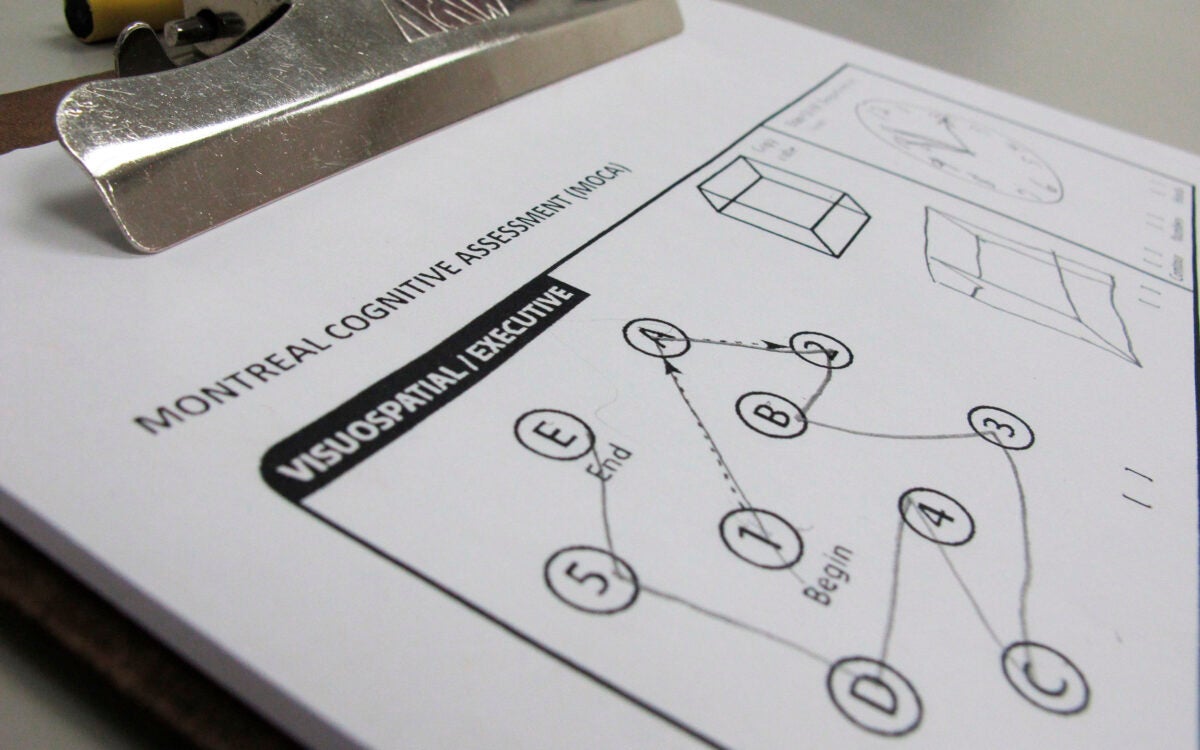
Testing fitness of aging brain

DNR orders for Down syndrome patients far exceeded pandemic norm

Binge eating appears more widespread, persistent than thought

Getty Images
Researchers reverse hair loss caused by alopecia
Treatment holds promise for painlessly targeting affected areas without weakening immune system
BWH Communications
Researchers have developed a novel treatment to reverse hair loss caused by the autoimmune disease alopecia areata, using a microneedle patch to painlessly target affected areas of the skin.
Alopecia areata causes hair loss when T cells mistakenly attack follicles. To restore control over hyperactive immune cells, researchers from Brigham and Women’s Hospital and MIT delivered T cell regulators directly to sites of hair loss to halt autoimmune activity. Findings, published in Advanced Materials , demonstrated marked and lasting increases in hair regrowth in mice models of the disease.
Our immune system evolved to safeguard against the overactivation that occurs in autoimmune conditions. In alopecia areata, the specialized cells known as Regulatory T cells (T-regs) fall short in protecting hair follicles. Current immunosuppressants used to treat alopecia areata target both T cells and T-regs, failing to address the core issue and increasing the risk of disease recurrence once treatment stops. By suppressing the entire immune system, they leave patients vulnerable to infections.
Rather than globally suppressing the immune system, the approach tested in this study locally restores immune activity directly at sites of hair loss by increasing levels of T-regs. This targeted approach was achieved with a microneedle patch, which delivers drugs across the tough outer layer of skin more effectively than topical creams and avoids stimulation of pain receptors located deeper within the skin.
“Our strategy tackles two major challenges in treating autoimmune skin diseases,” said co-corresponding author Natalie Artzi of the Brigham’s Engineering in Medicine Division in the Department of Medicine. “Our patches enable local delivery of biologics, which, instead of suppressing the immune system, promote regulatory T cells in the skin. This restores immune balance and resolves the T cell attack on hair follicles, offering a potential long-term solution without compromising the immune system’s ability to defend against infections and malignancies.”
“When it comes to autoimmune-mediated skin diseases, where we have direct access to the skin, we must surpass the use of systemic immunosuppressants that shut down the entire immune system,” said co-corresponding author Jamil Azzi , an immunologist in the Brigham’s Renal Division in the Department of Medicine. “While topical therapy often fails to penetrate the skin’s outer layer, our patches improve the local delivery of biologics to the deeper layers of diseased skin and reprogram the immune system to generate tolerance at the site of antigen encounter.”
“Our strategy tackles two major challenges in treating autoimmune skin diseases.” Natalie Artzi
The researchers, including co-first authors Nour Younis and Núria Puigmal, both of Brigham’s Department of Medicine, observed with RNA sequencing that in alopecia tissues, there were changes in the STAT-5/Interleukin-2 (IL-2), a signaling pathway that promotes T-reg proliferation. IL-2 and CCL22, which the researchers had previously shown attract and expand the presence of T-regs in a specific area, were loaded into the microneedle patch. The patches were applied to mice models of alopecia 10 times over a course of three weeks, with more than eight weeks of observation. Hair regrowth was observed as early as three weeks after the initiation of treatment. The researchers also tested microneedle patches loaded with baricitinib, a drug approved for severe alopecia areata, but found that T-reg recruitment was inferior to that associated with the IL-2/CCL22 patch.
The microneedle patch also was found to have good shelf-life stability, improving prospects of its clinical translation. While the therapy is not ready for clinical use, the researchers are pursuing further development and testing. Additionally, they are exploring the possibility of applying their approach to other immune-mediated skin diseases, such as vitiligo and psoriasis.
“Microneedles offer a promising avenue for targeted and localized delivery of therapeutics to the skin,” said Artzi. “Their ability to precisely administer drugs directly to the affected area of the skin enables more effective modulation of the immune response while minimizing systemic side effects. This targeted approach holds great potential for improving treatment outcomes and reducing the burden of autoimmune and immune-mediated diseases on patients’ lives.”
Other co-authors from Brigham include Andrew Badaoui, Dongliang Zhang, Claudia Morales, Anis Saad, Diane Cruz, Nadim Al Rahy, Andrea Daccache, Triana Huerta, Christa Deban, Ahmad Halawi, John Choi, Pere Dosta, Christine Lian, and Abdallah El Kurdi.
Funding: The Department of Medicine at Brigham and Women’s Hospital supported this work through the Ignite Fund Award and the Shark Tank Fund Award.
Share this article
You might like.
Most voters back cognitive exams for older politicians. What do they measure?

Co-author sees need for additional research and earlier, deeper conversations around care

New research takes broader, deeper look at common, but poorly understood, disorder
More than a planetary fender-bender
New study finds Earth collided with dense interstellar cloud, possibly affecting life on planet
Alzheimer’s disease indicators track with biological changes in brain, study finds
Researchers see self-reported memory loss may be early, preclinical warning
Scaling Investments in Climate and Health: Launch of the Development Banks’ Joint Roadmap for Climate-Health Finance and Action
- Google Calendar
- Yahoo! Calendar
- iCal Calendar
- Outlook Calendar
Watch Recording
Watch recordings in Arabic | French | Spanish
Climate change is the greatest threat to health and wellbeing facing the world in the 21st century. The climate crisis is estimated to push 132 million people into extreme poverty by 2030—one-third of these will be driven by the impacts of climate change on health alone. Despite the outsized impact, current investments in the nexus of climate change and health are extremely low.
To increase and prioritize investments at the scale needed to sustainably finance climate and health action, we need partnerships across institutional and sectoral boundaries to identify the most impactful and cost-effective solutions.
The Development Bank Working Group for Climate-Health Finance, established in July 2023, comprises Multilateral Development Banks (MDB) and Public Development Banks (PDBs). The goal of the group is to enhance its collective impact by supporting countries to respond to the health impacts of climate change and elevating the health sector's role in climate change adaptation and mitigation.
This event will introduce the new Roadmap for Climate-Health Finance and Action of the Development Bank Working Group. The roadmap outlines a common, strategic approach to urgently raise, prioritize, and drive climate and health commitments to finance a people-centered approach for climate and health action. The event will answer these questions:
- What is the impact of climate on health and poverty and why is there an urgent need for significant, coordinated investments in climate and health?
- What is the role and comparative advantage of development banks in mobilizing financial resources, technical expertise, and policy influence for climate and health action?
- What are key opportunities for innovation and co-investment in climate and health?
( High-Level Agenda )
7.00 |
|
7.03 |
|
| 7:05 |
|
7:30 |
|
7.55 |
|

Development Banks’ Joint Roadmap for Climate-Health Finance and Action
For the first time, eleven Multilateral and Public Development Banks have come together to optimize their efforts and maximize investments in climate and health. Together, the group has developed the Joint Roadmap for Climate-Health Finance and Action (PDF) , which outlines a common strategy to urgently increase and prioritize investments responding to the health impacts brought about by climate change.
With a focus on strong partnerships with governments, civil society, the private sector, and other stakeholders to tailor investments to specific country needs, the roadmap outlines six areas to guide this collective approach:
- adopting a common understanding of climate-health investments;
- identifying country and regional vulnerabilities and needs;
- building capacity in climate and health at the sub-national, national, regional, and global levels, including in the private sector;
- supporting country-tailored, evidence-based interventions;
- mobilizing synergistic financing;
- focusing on results, transparency and accountability.
Event Details
- Date: June 12, 2024
- Time: 7:00-8:00 am Eastern Daylight Time / 7:00-8:00 pm Philippine Standard Time
Report: Roadmap for Climate-Health Finance and Action (PDF)
This site uses cookies to optimize functionality and give you the best possible experience. If you continue to navigate this website beyond this page, cookies will be placed on your browser. To learn more about cookies, click here .
- Download PDF
- Share X Facebook Email LinkedIn
- Permissions
Melatonin and Risk of Age-Related Macular Degeneration
- 1 Case Western Reserve University School of Medicine, Cleveland, Ohio
- 2 Center for Ophthalmic Bioinformatics, Cole Eye Institute, Cleveland Clinic, Cleveland, Ohio
- 3 Cleveland Clinic Martin Health, Cleveland Clinic Florida, Stuart
Question What is the association between melatonin use and the development and progression of age-related macular degeneration (AMD)?
Findings In this cohort study of 121 523 patients with no history of AMD aged 50 years or older, taking melatonin was associated with a decreased risk of developing AMD. Likewise, among 66 253 patients with preexisting nonexudative AMD, melatonin supplementation was negatively associated with the rate of progression to exudative AMD.
Meaning These findings provide a rationale for expanding clinical research on the potential therapeutic efficacy of melatonin in preventing AMD development or its progression.
Importance Melatonin has been shown to oppose several processes that are known to mediate age-related macular degeneration (AMD), but whether melatonin can confer benefits against AMD remains unclear.
Objective To examine the association between melatonin supplementation and the risk of the development or progression of AMD.
Design, Setting, and Participants This retrospective cohort study accessed data from TriNetX, a national database of deidentified electronic medical records from both inpatient and outpatient health care organizations across the US, between December 4, 2023, and March 19, 2024. Patients aged 50 years or older, 60 years or older, and 70 years or older with no history of AMD (AMD-naive group) and with a history of nonexudative AMD (nonexudative AMD group) were queried for instances of melatonin medication codes between November 14, 2008, and November 14, 2023. Patients were then classified into either a melatonin group or a control group based on the presence of medication codes for melatonin. Propensity score matching (PSM) was performed to match the cohorts based on demographic variables, comorbidities, and nonmelatonin hypnotic medication use.
Exposure The presence of at least 4 instances of melatonin records that each occurred at least 3 months apart.
Main Outcomes and Measures After PSM, the melatonin and the control cohorts were compared to evaluate the risk ratios (RRs) and the 95% CIs of having an outcome. For the AMD-naive group, the outcome was defined as a new diagnosis of any AMD, whereas for the nonexudative AMD group, the outcome was progression to exudative AMD.
Results Among 121 523 patients in the melatonin-naive group aged 50 years or older (4848 in the melatonin cohort [4580 after PSM; mean (SD) age, 68.24 (11.47) years; 2588 female (56.5%)] and 116 675 in the control cohort [4580 after PSM; mean (SD) age, 68.17 (10.63) years; 2681 female (58.5%)]), melatonin use was associated with a reduced risk of developing AMD (RR, 0.42; 95% CI, 0.28-0.62). Among 66 253 patients aged 50 years or older in the nonexudative AMD group (4350 in the melatonin cohort [4064 after PSM; mean (SD) age, 80.21 (8.78) years; 2482 female (61.1%)] and 61 903 in the control cohort [4064 patients after PSM; mean (SD) age, 80.31 (8.03) years; 2531 female (62.3%)]), melatonin was associated with a reduced risk of AMD progression to exudative AMD (RR, 0.44; 95% CI, 0.34-0.56). The results were consistent among subsets of individuals aged 60 years or older (AMD-naive cohort: RR, 0.36 [95% CI, 0.25-0.54]; nonexudative AMD cohort: RR, 0.38 [95% CI, 0.30-0.49]) and 70 years or older (AMD-naive cohort: RR, 0.35 [95% CI, 0.23-0.53]; nonexudative AMD cohort: RR, 0.40 [95% CI, 0.31-0.51]).
Conclusions and Relevance Melatonin use was associated with a decreased risk of development and progression of AMD. Although lifestyle factors may have influenced this association, these findings provide a rationale for further research on the efficacy of using melatonin as a preventive therapy against AMD.
Read More About
Jeong H , Shaia JK , Markle JC , Talcott KE , Singh RP. Melatonin and Risk of Age-Related Macular Degeneration. JAMA Ophthalmol. Published online June 06, 2024. doi:10.1001/jamaophthalmol.2024.1822
Manage citations:
© 2024
Artificial Intelligence Resource Center
Ophthalmology in JAMA : Read the Latest
Browse and subscribe to JAMA Network podcasts!
Others Also Liked
Select your interests.
Customize your JAMA Network experience by selecting one or more topics from the list below.
- Academic Medicine
- Acid Base, Electrolytes, Fluids
- Allergy and Clinical Immunology
- American Indian or Alaska Natives
- Anesthesiology
- Anticoagulation
- Art and Images in Psychiatry
- Artificial Intelligence
- Assisted Reproduction
- Bleeding and Transfusion
- Caring for the Critically Ill Patient
- Challenges in Clinical Electrocardiography
- Climate and Health
- Climate Change
- Clinical Challenge
- Clinical Decision Support
- Clinical Implications of Basic Neuroscience
- Clinical Pharmacy and Pharmacology
- Complementary and Alternative Medicine
- Consensus Statements
- Coronavirus (COVID-19)
- Critical Care Medicine
- Cultural Competency
- Dental Medicine
- Dermatology
- Diabetes and Endocrinology
- Diagnostic Test Interpretation
- Drug Development
- Electronic Health Records
- Emergency Medicine
- End of Life, Hospice, Palliative Care
- Environmental Health
- Equity, Diversity, and Inclusion
- Facial Plastic Surgery
- Gastroenterology and Hepatology
- Genetics and Genomics
- Genomics and Precision Health
- Global Health
- Guide to Statistics and Methods
- Hair Disorders
- Health Care Delivery Models
- Health Care Economics, Insurance, Payment
- Health Care Quality
- Health Care Reform
- Health Care Safety
- Health Care Workforce
- Health Disparities
- Health Inequities
- Health Policy
- Health Systems Science
- History of Medicine
- Hypertension
- Images in Neurology
- Implementation Science
- Infectious Diseases
- Innovations in Health Care Delivery
- JAMA Infographic
- Law and Medicine
- Leading Change
- Less is More
- LGBTQIA Medicine
- Lifestyle Behaviors
- Medical Coding
- Medical Devices and Equipment
- Medical Education
- Medical Education and Training
- Medical Journals and Publishing
- Mobile Health and Telemedicine
- Narrative Medicine
- Neuroscience and Psychiatry
- Notable Notes
- Nutrition, Obesity, Exercise
- Obstetrics and Gynecology
- Occupational Health
- Ophthalmology
- Orthopedics
- Otolaryngology
- Pain Medicine
- Palliative Care
- Pathology and Laboratory Medicine
- Patient Care
- Patient Information
- Performance Improvement
- Performance Measures
- Perioperative Care and Consultation
- Pharmacoeconomics
- Pharmacoepidemiology
- Pharmacogenetics
- Pharmacy and Clinical Pharmacology
- Physical Medicine and Rehabilitation
- Physical Therapy
- Physician Leadership
- Population Health
- Primary Care
- Professional Well-being
- Professionalism
- Psychiatry and Behavioral Health
- Public Health
- Pulmonary Medicine
- Regulatory Agencies
- Reproductive Health
- Research, Methods, Statistics
- Resuscitation
- Rheumatology
- Risk Management
- Scientific Discovery and the Future of Medicine
- Shared Decision Making and Communication
- Sleep Medicine
- Sports Medicine
- Stem Cell Transplantation
- Substance Use and Addiction Medicine
- Surgical Innovation
- Surgical Pearls
- Teachable Moment
- Technology and Finance
- The Art of JAMA
- The Arts and Medicine
- The Rational Clinical Examination
- Tobacco and e-Cigarettes
- Translational Medicine
- Trauma and Injury
- Treatment Adherence
- Ultrasonography
- Users' Guide to the Medical Literature
- Vaccination
- Venous Thromboembolism
- Veterans Health
- Women's Health
- Workflow and Process
- Wound Care, Infection, Healing
- Register for email alerts with links to free full-text articles
- Access PDFs of free articles
- Manage your interests
- Save searches and receive search alerts
Still accepting applications for online and hybrid programs!
- Skip to content
- Skip to search
- Accessibility Policy
- Report an Accessibility Issue

- University of Michigan receives $6.7M grant to study flu immunity in children

June 7, 2024
No parent wants to see their baby sick. But a child's first exposure to influenza is actually very important—it can impact their natural protection against future flu viruses.

Now, Gordon, a professor of epidemiology and global public health at Michigan Public Health, has been awarded a $6.7 million five-year grant to advance her innovative research into influenza immunity development among children. Flu Lab , an organization that supports efforts to advance innovative solutions to persistent problems in the prevention and treatment of influenza, has funded the grant for Gordon's FluGuardians: Michigan Influenza Immunity Cohort through the end of 2028.
"This study represents a monumental step toward understanding how early influenza exposure—whether through infection or vaccination—shapes the immune systems of children in the long term," said Gordon, who is also principal investigator at the University of Michigan Biosciences Initiative's Michigan Center for Infectious Disease Threats. "We're immensely grateful to Flu Lab for supporting research that has the potential to transform our approach to influenza prevention and immunity."
University of Michigan's Research Foundations Partnerships Office , launched in 2023, played a critical role in helping to secure funding for this project.
Gordon and her research team will focus on the comprehensive study of flu immunity development, from infancy through childhood. The ambitious project aims to enroll up to 850 infants in Ann Arbor within six weeks of birth, with the goal of closely following their immune responses to both influenza infection and vaccination.
The FluGuardians study is leveraging a Michigan Medicine-led food allergy cohort study, the Michigan Sibling Immunity Birth Study, which is also enrolling participants this year. With 680 to 765 healthy children anticipated to participate in both studies, the research will not only investigate natural infection and vaccine-imprinted immune responses but also examine the broader immunological landscape, including innate immunity.
The study's techniques include standard serological testing, systems serology using Luminex technology, and advanced machine learning methods to analyze the complex data. Supplementing Gordon's established Dissection of Influenza Vaccination and Infection for Childhood Immunity Consortium study—conducted in partnership with St. Jude Children's Research Hospital—the research will explore how initial exposures shape B and T cell responses, potentially leading to recommendations for tailoring immunizations in children.
"The community in Ann Arbor, known for its high infant influenza vaccination rates and enthusiastic participation in research studies, offers a prime setting for this cohort study," Gordon said. "Our connection with the local population, combined with their consistent engagement, provides a unique opportunity to address important questions about influenza immunity."
The findings from the study are expected to not only contribute significantly to the field of influenza research but also to inform strategies for the development and evaluation of next-generation and universal flu vaccines.
What Is Imprinting?
The very first flu virus you encounter can have a long-lasting influence on how your immune system responds to flu viruses in the future. Through a process called imprinting, our bodies create antibodies the first time we get the flu, and researchers have found that these antibodies stick with us for the rest of our lives. "Every time we encounter a flu virus with similarities, our immune system tends to rely on past responses rather than creating a new one," Gordon said. "While this can sometimes be effective, other times it can lead to a less optimal response, making it harder to fight off new strains. For example, due to imprinting, your immune system might use old tactics to fight off a virus, which might not be perfectly suited to fighting the new virus."
In addition, there is some evidence that this first exposure to the flu may protect you against severe infection from novel flu viruses, like H5N1, in the event of a pandemic. But how this occurs is not known.
Contact Andrea LaFerle Director of Public Relations and Marketing University of Michigan School of Public Health [email protected] 734-764-8094
- Epidemiology
- Child Health
- Global Public Health
- Infectious Disease
Recent Posts
- Roshanak Mehdipanah attends Presidential Advisory Council on Combating Antibiotic-Resistant Bacteria meeting in Washington, D.C.
- New AI-powered statistics method has potential to improve tissue and disease research
- Apple Hearing Study reveals prevalence of tinnitus
What We’re Talking About
- Adolescent Health
- Air Quality
- Alternative Therapies
- Alumni News and Networking
- Biostatistics
- Chronic Disease
- Community Partnership
- Computational Epidemiology and Systems Modeling
- Disaster Relief
- Diversity Equity and Inclusion
- Engaged Learning
- Environmental Health
- Epidemiologic Science
- Epigenetics
- First Generation Students
- Food Policy
- Food Safety
- General Epidemiology
- Global Health Epidemiology
- Health Behavior and Health Education
- Health Care
- Health Care Access
- Health Care Management
- Health Care Policy
- Health Communication
- Health Disparities
- Health Informatics
- Health for Men
- Health for Women
- Heart Disease
- Hospital Administration
- Hospital and Molecular Epidemiology
- Immigration
- Industrial Hygiene
- Internships
- LGBT Health
- Maternal Health
- Mental Health
- Mobile Health
- Occupational and Environmental Epidemiology
- Pain Management
- Pharmaceuticals
- Precision Health
- Professional Development
- Reproductive Health
- Scholarships
- Sexual Health
- Social Epidemiology
- Social Media
- Student Organizations
- Urban Health
- Urban Planning
- Value-Based Care
- Water Quality
- What Is Public Health?
Information For
- Prospective Students
- Current Students
- Alumni and Donors
- Community Partners and Employers
- About Public Health
- How Do I Apply?
- Departments
- Findings magazine
Student Resources
- Career Development
- Certificates
- The Heights Intranet
- Update Contact Info
- Report Website Feedback

IMAGES
VIDEO
COMMENTS
Learn about the history, types, examples, and strategy of research and development (R&D) in industry. R&D is the process of creating new products and processes through technological innovation.
R&D is the series of activities that companies undertake to innovate and introduce new products and services or to improve their existing offerings. Learn about the different types of R&D, the advantages and disadvantages, and the accounting treatment for R&D costs.
Research and development ( R&D or R+D; also known in Europe as research and technological development or RTD) [1] is the set of innovative activities undertaken by corporations or governments in developing new services or products, and improving existing ones. [2] [3] Research and development constitutes the first stage of development of a ...
Research development. Research development ( RD) is a set of strategic, proactive, catalytic, and capacity-building activities designed to facilitate individual faculty members, teams of researchers, and central research administrations in attracting extramural research funding, creating relationships, and developing and implementing strategies ...
Learn how to overcome the challenges and barriers that prevent R&D from delivering value and shaping corporate strategy. Discover the three steps to create a robust R&D strategy that connects with customers, measures progress, and prioritizes transformational projects.
Research and Development is a systematic activity that companies undertake to innovate and introduce new products and services or to improve their existing offerings. Many people think of pharmaceutical and technology companies when they hear "R&D," but other firms, including those that produce consumer products, invest time and resources ...
As a research institution, this investment is most often in man-hours spent. developing the initial research proposal. In 2018, the United States government spent $142.9 billion funding research and. development activities.1 This funding makes up only a portion of the overall research.
This chapter explores the main themes, concepts, and issues of research and development (R&D) in universities around the world. It covers the rationale, funding, roles, impediments, and future of R&D, with a focus on the Arab world and developing economies.
Research and development (R&D) is a broad category describing the entity of basic research, applied research, and development activities. In general research and development means systematic activities in order to increase knowledge and use of this knowledge when developing new products, processes, or services. Nowadays innovation activities ...
Research and development (R&D) refers to the activities that businesses engage in to: Develop and introduce new products and services or. Innovate and improve on existing products and services. R&D can be an invaluable tool for building and enhancing your business. It involves conducting a thorough investigation into your industry, your ...
Research and development (R&D) refers to two intertwined processes of research (to identify new knowledge and ideas) and development (turning the ideas into tangible products or processes). Companies undertake R&D in order to develop new products, services, or procedures that will help them grow and expand their operations. Corporate R&D began ...
Research and development (R&D) refers to the set of activities companies undertake to innovate and introduce new products and services or improve existing ones. Advertisements. It goes from generating initial ideas to commercializing final products or implementing new processes. R&D enables companies to stay competitive and meet evolving market ...
Explore data, visualizations, and writing on research, development, and innovation across various domains and topics. Learn how research has transformed our lives, societies, and challenges.
Research and development (R&D) by pharmaceutical firms focuses disproportionately on medical conditions afflicting the elderly. The proportion of R&D spending targeting older age groups is increasing over time. Even though these investments in R&D prolong life expectancy and improve quality of life, they have little effect on measured ...
Research and development (R&D) is an important part of the product development process of a business. It is a common method used by businesses and corporations to come up with new ideas to find a competitive edge in the market. It is a process that allows them to uncover innovative knowledge, whether it is about their customer or the products ...
Pure research, also known as basic research, is an important early step in the research and development process. It is defined as an activity that seeks to increase scientific knowledge without ...
A research design is a strategy for answering your research question using empirical data. Creating a research design means making decisions about: Your overall research objectives and approach. Whether you'll rely on primary research or secondary research. Your sampling methods or criteria for selecting subjects. Your data collection methods.
The National Organization of Research Development Professionals (NORDP) defines the goal of Research Development offices as supporting the efforts of faculty to secure extramural research funding and initiate and nurture critical partnerships throughout the institutional research enterprise, among institutions, and with external stakeholders.
Reach out to the Office of Research and Economic Development by email or by phone at 208-885-6689 today. Office of Research & Economic Development. Physical Address: Morrill Hall 105. Mailing Address: 875 Perimeter Drive MS 3010 University of Idaho Moscow, ID 83844-3010. Phone: 208-885-5663.
Additional Research Programs. Research Training Diversity Small Business Human Subjects Research Translational Research. NIDDK supports the training and career development of medical and graduate students, postdoctoral fellows, and physician scientists through institutional and individual grants. Learn about NIDDK Research Training Programs.
The Research, Society and Development journal (whose abbreviated title is Res., Soc. Dev.) is a multidisciplinary scientific publication focused on promoting the social, scientific and technological development through the publication of the findings that have occurred in different areas. This is a monthly journal, which publishes various types of manuscript, such as scientific articles ...
Keywords: science, technology, innovation, science financing, technological sovereignty, public administration. Introduction. Almost all countries and experts consider science and technology to be the main driver of modern development. In Russia, science employs almost 0.8% of all those working in the national economy and creates 1.4% of GDP.
The NIDCD's research training and career development opportunities fall into two broad categories: Extramural support for research training and career development at institutions throughout the U.S. These include individual fellowships, institutional awards, career development awards, and other opportunities. For application details, see How ...
Our collaboration with scientists. builds on a deep foundation of engineering know-how. We delve into every detail and nuance to meet the challenge of developing and scaling knowledge-intensive devices. About company.
Today, NOAA and the U.S. Department of Energy (DOE) signed a memorandum of agreement (MOA) on future collaborations regarding marine carbon dioxide removal research and development. As a climate solution, marine carbon dioxide removal is an important pathway to achieve the broader Biden Administration goal for the U.S. to reach net-zero emissions of greenhouse gases by 2050.
Penn State is currently seeking a top frontline fundraiser in the role of Assistant/Associate Director of Development to engage alumni and friends as partners in supporting the College of Engineering, one of the nation's leading educators of world-class engineers and leading producers of world-class research. As a member of the Division of Development and Alumni Relations (DDAR), […]
Researchers have developed a novel treatment to reverse hair loss caused by the autoimmune disease alopecia areata, using a microneedle patch to painlessly target affected areas of the skin. Alopecia areata causes hair loss when T cells mistakenly attack follicles. To restore control over hyperactive immune cells, researchers from Brigham and ...
The Development Bank Working Group for Climate-Health Finance, established in July 2023, comprises Multilateral Development Banks (MDB) and Public Development Banks (PDBs). The goal of the group is to enhance its collective impact by supporting countries to respond to the health impacts of climate change and elevating the health sector's role ...
Importance Melatonin has been shown to oppose several processes that are known to mediate age-related macular degeneration (AMD), but whether melatonin can confer benefits against AMD remains unclear.. Objective To examine the association between melatonin supplementation and the risk of the development or progression of AMD.. Design, Setting, and Participants This retrospective cohort study ...
University of Michigan's Research Foundations Partnerships Office, launched in 2023, played a critical role in helping to secure funding for this project. Gordon and her research team will focus on the comprehensive study of flu immunity development, from infancy through childhood.